

Sideburn is published four times a year by Inman Ink Ltd


Editor: Gary Inman
Deputy editor: Mick Phillips
Art editor: Kar Lee Entertainments officer: Dave Skooter Farm
Test rider: Travis Newbold
For advertising/commercial enquiries please email: sideburnmag@gmail.com
©2019 Sideburn magazine ISSN 2040-8927
None of this magazine can be reproduced without publisher’s consent sideburnmag@gmail.com
This perfect-bound slab of moto thought and still image was created by a team of friends, supporters and allies around the world. We thank the following: Javi Echevarría Ruiz; Stefan L; Ed Subias; Jared Mees; Shayna Texter; Johnny Lewis; Eddie Mulder; Dan Mahony; Scott Fuel; Ronnie Jones; Ryan Quickfall; Paul at S&S; Scott Toepfer; Giselle at AFT; Tom Bing; Christoffer Martensson; Paul France; Braking Point Images; All at the DTRA; Omar Rosa; David Death Spray; all at AFT; all at Red Torpedo; Neryl Walker; Stefan Marjoram; Matt at MotoAttic; Dave Bevan; Max I; Leah Tokelove; Cheetah; Lenny Schuurmans; Paul Hartman; Nathalie Legrand; Adrian Mortimer; and our loyal advertisers. Please support those who support the scene. Thank you for buying Sideburn.
The opinions expressed in Sideburn magazine are those of the author(s) and do not necessarily reflect the opinions of the magazine’s publisher or editors.

Hanging Around
Cover 1: Koolt XT600 by Javi Echevarria
Cover 2: Jared Mees by Ed Subias
This page: Caylee Hankins
SIDEBURN 39 will be published in December 2019. To subscribe go to sideburn.bigcartel.com

Why is this KTM Thunderbike dangling in East London? Find out on p52

3
@sideburnmag sideburnmag sideburnmagazine.com
A BIKER’S WORK IS NEVER DONE


PARTS AND ACCESSORIES FOR HARLEY-DAVIDSON MOTORCYCLES SINCE 1979
Pick of the month Wrecking Crew Sweater Get it at wwag.com

85 DIRT TRACK DANDY Nudie-inspired leathers and a hot Yamaha 77 EPIPHANIC Blitzing Montlhéry on an ancient Harley 22 KEEPING UP WITH THE JONES Ronnie Jones’ scrapbook 6 I AM WHO I AM Koolt XT600E inspires new commandments 69 CHAMPION Vintage Bonneville racer 60 FLYING ’57 Bianchi Rotax hot rod tracker 30 SHORT BRUTAL GNARLY The Lima pea gravel half-mile 44 SOMETHING DIFFERENT Survivor Honda CRF450 framer 52 WICKED WINCH Living with a third-floor workshop 90 DIRT PERVERT George Pickering of Greenfield Dirt Track 98 BAILO 2019 DTRA Pro champ 106 BONNIE HOOLIGAN Super clean 5 Regulars 18 Interview: Ronnie Jones 28 Get Schooled: Get back to basics 101 Have Fun page 103 Schuurmans’ Backflash 104 Project Bike 108 Racewear 111 Sideburn merch 112 Death Spray Custom inspiration 114 Trophy Queen Illustration: Ryan Quickfall
I am who
am
Stefan Lantschner’s
with his 1992
made us examine street tracker

I
relationship
Yamaha XT600E
existentialism Words: Dave Skooter Farm Photos: Javi Echevarría Ruiz


7 >
An Italian in Spain, Stefan grew up speaking German. Koolt is an amalgam of cool and cult

ccording to the ancient scriptures of the Bible, when Moses asked who God was, he simply replied ‘I am who I am’. What does that even mean? We are supposed to look to God as a role model, so I’d guess it’s a veiled validation to go out and carve your own block. To commemorate their meeting, God gave Moses the Ten Commandments, a set of rules for all human beings to
Koolt Yamaha XT600E
Engine Stock with custom exhaust by Christoffer Martensson
Chassis XT frame with subframe by owner; Bultaco Lobito one-piece fuel tank, seat, sidepanels; Yamaha R6 forks; custom top yoke Everything else R6 front caliper; KTM front disc; Magura master cylinders and levers; seat cover by Xtrimseat; carbon front plate by owner/Ricardo Lazarte
live by. Seeing the great job Stefan Lantschner made of his Yamaha XT600E, how he avoided many of the pitfalls 21st century bike builders continually succumb to, got us thinking about a specific set of commandments for the modern-day custom builder. Naturally, like the original Bible scriptures, ours are full of contradiction, hypocrisy and vagueness (and a little sarcasm. Who wouldn’t love a sarcastic deity?).


>
Thou shalt not build by committee Buck the trend. Shift toward self-centredness and strive for God’s perfect design.
Thou shalt not think rich but act poor Contrived patina is nothing more than a mere graven image.
Thou shalt avoid the quicksand of debt Create within your means. Commit to actions that benefit your pocket. Soulless expense is no substitute for true inventiveness.
Thou shalt not worship false idols Do not bestow excessive devotion on charlatan influencers.
Thou shalt not waste unnecessary time wrapping exhausts
There is scarred beauty in unabashed corrosion.
Thou shalt renovate the motor in order to renovate the heart Spiritual satisfaction and divine security are born from a timely-fashioned engine rebuild.
Thou shalt be upfront and honest when asking for help with a wiring problem Help gifted under false pretences leads to resentment. Forthrightness is always the best policy.
Thou shalt not covet thy neighbour’s toolkit
Cultivate thy own collection of good, dependable tools, keeping them close by, until death do you part.
Thou shalt endure skinned knuckles with humility
A strong man withstands everything that comes against him.
Thou shalt not build an arrogant, unridable pig-dog Build according to circumstances and surroundings but beware, do nothing out of selfish ambition or vain conceit.
Thou shalt not affix race plates to a street bike that was never raced Surrender and lay your mistakes at the foot of the cross.
Thou shalt redeem your time Maintain passion and excitement. Spend more time in the saddle than in the workshop.
the NEW commandments 5 5
Like a hawk perched looking for prey. This lowly XT has climbed the food chain
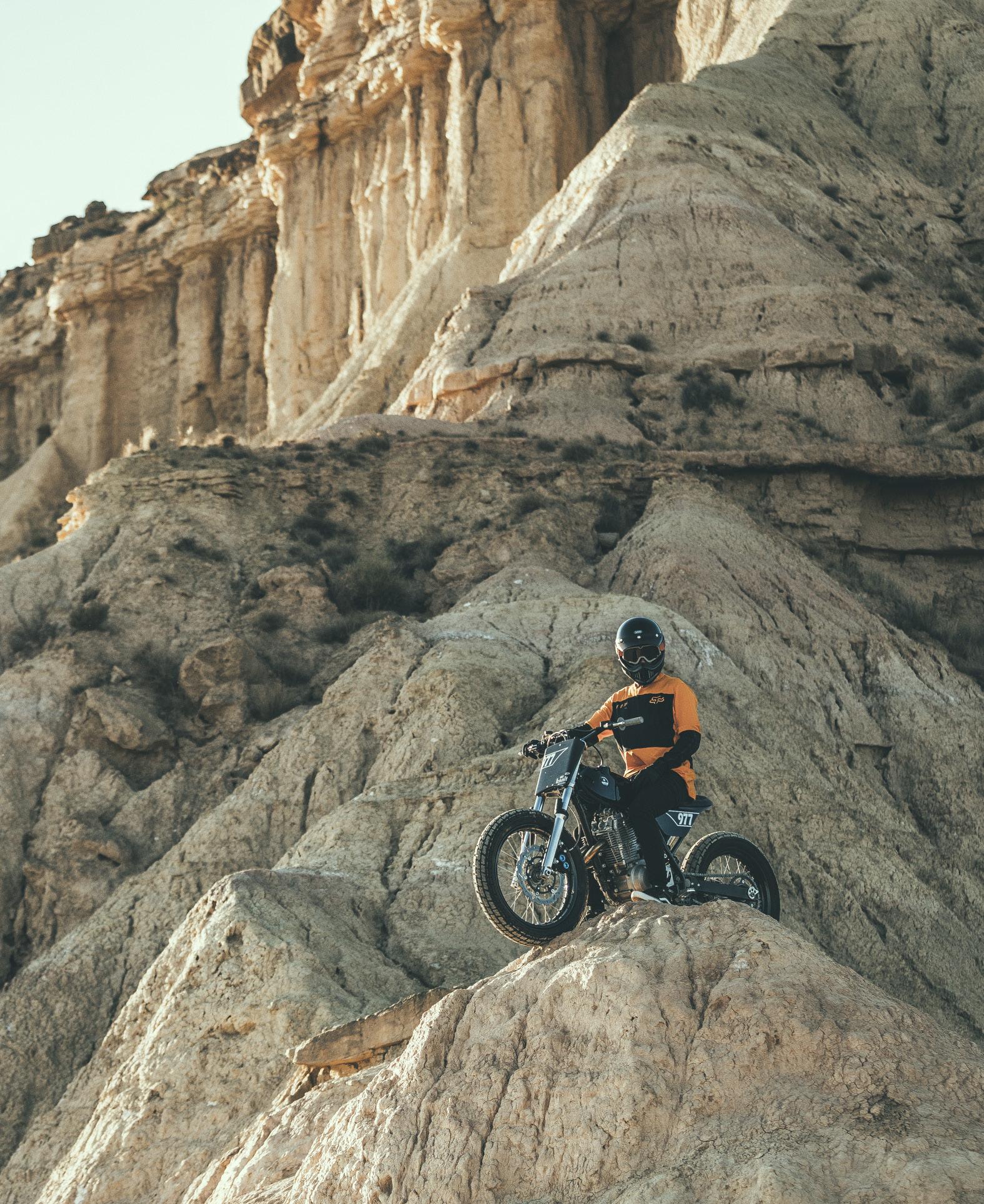
>

In the desert, three hours outside Barcelona, raging until he highsided...

>
Thanks: Niks Motorcycles; Salva; Luis Angel; Nico; Josh and Stevo; Chris; Javi and Mitu; Magura for all the sick parts and a huge thanks to Alvaro Montal for leaving me his garage in Barcelona so I can work on my bikes


BORN ON THE DIRT. BUILT FOR THE STREET.
BORN ON THE DIRT. BUILT FOR THE STREET.
Inspired by the championship winning FTR750 race bike.
Inspired by the championship winning FTR750 race bike.
The FTR ™1200


The FTR ™1200






American motorcycling.
American motorcycling.

sets a new standard for
A2 version available on FTR ™ 1200 base model. @indianmotorcycleuk @indianmotorcycleuk
sets a new standard for
A2 version available on FTR ™ 1200 base model. @indianmotorcycleuk @indianmotorcycleuk



INDIANMOTORCYCLE.CO.UK
Professional rider. Closed course. Do not attempt.
Who? What? When? Why? Where?
Ronnie Jones
Interview: Gary Inman Illustrations: Neryl Walker
You’re 59 years old and still competing in professional American Flat Track Twins races, but when was your first motorcycle race?
It was in 1972 at a local short track in Yukon, Oklahoma. I was 11 years old. I raced a Yamaha Mini Enduro, a JT1, that was set up for flat track racing. It had little K&N filters, flat track handlebars and a Bob Bailey downpipe, so it was kinda cool. I felt like I was on a real flat track race bike. My buddy, whose bike it was, had gone on vacation with his mother to see his grandparents. His father was working, so he stayed in town and I ran into him at the local motorcycle shop on the day of the race. He said, ‘Well, Richard’s out of town, do you want to race his motorcycle?’ Are you kidding me? Then I had to go home and talk my parents into it. I thought motorcycles were the coolest thing.
I had a minibike, with a little Briggs and Stratton 3hp engine, when I was 8 or 9. I wanted a Honda Mini Trail, but I didn’t get one. When they came out with the Mini Enduro, I finally convinced my parents to get me one of those.
I loved motorcycles already, but I didn’t know anyone who could teach me about racing. When the movie On Any Sunday had come out, I’d had to go and see it. I was ten years old and once I watched Mert Lawwill open the back of his van, then it showed him out on the track and described how he earned his living, how he bought that house in Tiburon from racing motorcycles, I knew I was never going to work for the rest of my life, I was going to race motorcycles.
Appendix
When did you turn pro?
In 1977. There were three tiers in pro racing at that time. You had to be at least 16 and you came into the sport as a Novice. You couldn’t race anything bigger than a 250 as a Novice. You had to score enough points to move up to the next level. If you were a really good rider you could earn enough points by May, but you had to see out the whole season in the same class. The next level was Junior, where you rode the same motorcycles as an Expert, but you only competed against Juniors. We rode 250s on short tracks and you could ride up to a 750 on everything else.
What was your most memorable win?
The first win I ever got was the most unexpected and that made it pretty exciting. It was in the Houston Astrodome, a race I went to since I was about 12 years old to watch all my heroes. I went there in 1980, my second year as an Expert, and won. I had to beat Kenny Roberts, who had been national champion and was the world champion. I was riding a Viperframed1 Yamaha 250. The Astrodome was a two-night race. The first night was a TT, and all the Experts rode 750s, then the next night was a short track and all the Experts rode 250s.
I didn’t have tons of wins, so most of them have some significance to me, but the one that gets talked about the most was in my hometown of Oklahoma City. When I was growing up, there was a promoter who put a national race on every year in Oklahoma City. He was a
Harley dealer, and when he sold the dealership he quit promoting the race, so there were maybe 15 years where there wasn’t a race in Oklahama City. I always wanted to race in front of my hometown crowd, so in 1991 me and a partner decided to promote a race there. It was huge success and I ended up winning the race that first year. That was a big deal. At that point I was on a George Garvis Honda RS750. That year I also won the Daytona Short Track, then a week or two after Oklahoma I won the national at Rapid City, Sturgis. That was the most I ever won in a season, three nationals.
What are you racing this season, 2019?
I’m racing an Estenson Yamaha MT-07. Tim Estenson started his team last year with Yamahas with Jake Johnson. Previously, he’d run Yamahas with Sammy Halbert. Midway through the 2018 season Jake switched to Indians and let me ride one of his FTRs. This year he did a deal with Yamaha and Monster Energy and everyone has to be on a Yamaha.
I’ve missed the main by a spot or two2. It’s a brand new bike and it’s still in development. It’s a street bike, being developed for flat track.
What’s your favourite racetrack? When I was racing full time, whatever track I was riding that day was my favourite, but having said that, now I don’t have that requirement I’d say the Springfield Mile of the existing tracks. If we’re talking about the old tracks I’d say Ascot was probably my favourite. It was a track you could
1. Viper frames were made in Champagne, Illinois. 2. Between the interview and going to print Ronnie made the main at Sacramento.
>

19
race hard and it paid off. There was lots of traction. It was the only track I’ve won more than one national at. The atmosphere was electric. People were knowledgeable, they went every week, they were excited. It always attracted a good crowd. Being in Los Angeles, you had the movie people. You might see Gene Hackman walking around or The Beach Boys. It wasn’t a fancy place by any means, but it had this vibe that was unlike anywhere else.
What’s the best bike you ever raced?
The one I had the most success on was a Honda RS750, but the XR750 is still, even to this day, capable of winning a national, with the right rider on it.
And the worst?
I’ve been blessed to have really good bikes. The Estenson Yamaha is a really great motorcycle. It’s brand new and in development, so I’m having to learn it and it might be the toughest of any bike I’ve had to race. It’s fun, but it’s challenging.
In 1981 we tried to take a Suzuki DR500 enduro and make it a TT race bike and failed pretty miserably. That would be my least favourite.
Who is the greatest of all time?
Kenny Roberts was the most talented guy I ever raced against. Part of it was his sheer physical talent and part was his arrogance and his belief he was the best, plus he was too ignorant to see roadblocks in his way. There was a lot of brilliance there. He made a lot of very good decisions for a guy who didn’t make it out of elementary school. I think he dropped out of school in the sixth grade to race. The other one who I’d say had talent parallel to Kenny, at least on dirt, was Ricky Graham.
What’s the best thing about being a pro flat track racer?

I was able to travel, meet people, do so many things through my racing and made so many friends.
And the worst thing?
The tragedy connected to the sport.
Appendix
Very few people choose to make racing their vocation, because the risk/reward ratio is not there. There are very few people who make a living racing motorcycles and there are so many who get killed or injured it takes a special love of the sport for people to make the choice. It’s what makes the community as passionate as it is, you’re out there with people as crazy or ignorant as you.
If you had a magic wand to make one change to AFT, what would it be?
I’d make the rewards big enough for those willing to stick it out and make racing their career, so when they retire from racing they can without getting another job. Jared Mees is a little grinder, scrapping for everything. He’s racing a factory Indian and he’s sponsored by Las Vegas Harley-Davidson, I don’t know
could win $10,0003 for the Camel Challenge, a four-lap dash for cash in the 1990s. If you won the main event you could win another $6000.
Has anyone held a national number longer than you?
That’s a good question and I don’t know the answer, but over the period of time, between my first national number in 1980 and if I make a main event this year [2019], so I’ll have a national number in 2020, that’ll be a 40 year gap, and I know no one has done that. There were a few years in there where I didn’t compete, so I didn’t have a national number.4 I’m the only rider who has made a flat track national main event in five different decades: the ’70s, ’80s, ’90s, the ’00s and the teens. That’s why I’m racing this year, to see if I can make a main event in 2020, so it’ll extend the record into six different decades.
3. £10,000 in 1996 is the equivalent of $16,250 in 2019. final) at an American Flat Track national race. It’s not necessary to finish the whole race, making the main is enough to earn, or retain, the national number.

Ronnie Jones’s first pro flat track race was in 1977. He was inducted into the AMA Hall of Fame in 2016 and is preparing for the AFT Sacramento Mile races when we spoke. He’s not walking around in a starchy shirt and headset, he’s racing there, attempting to make the main with the Baumans, Carver, Vanderkooi, Robinson… Riders who weren’t even born when Ronnie won his first national, the season opener at the legendary Houston Astrodome. Here, he shares some of his photo archive that starkly shows the highs and lowest of lows he’s endured in flat track. Ronnie supplied the captions. GI the KeeeingJones up with





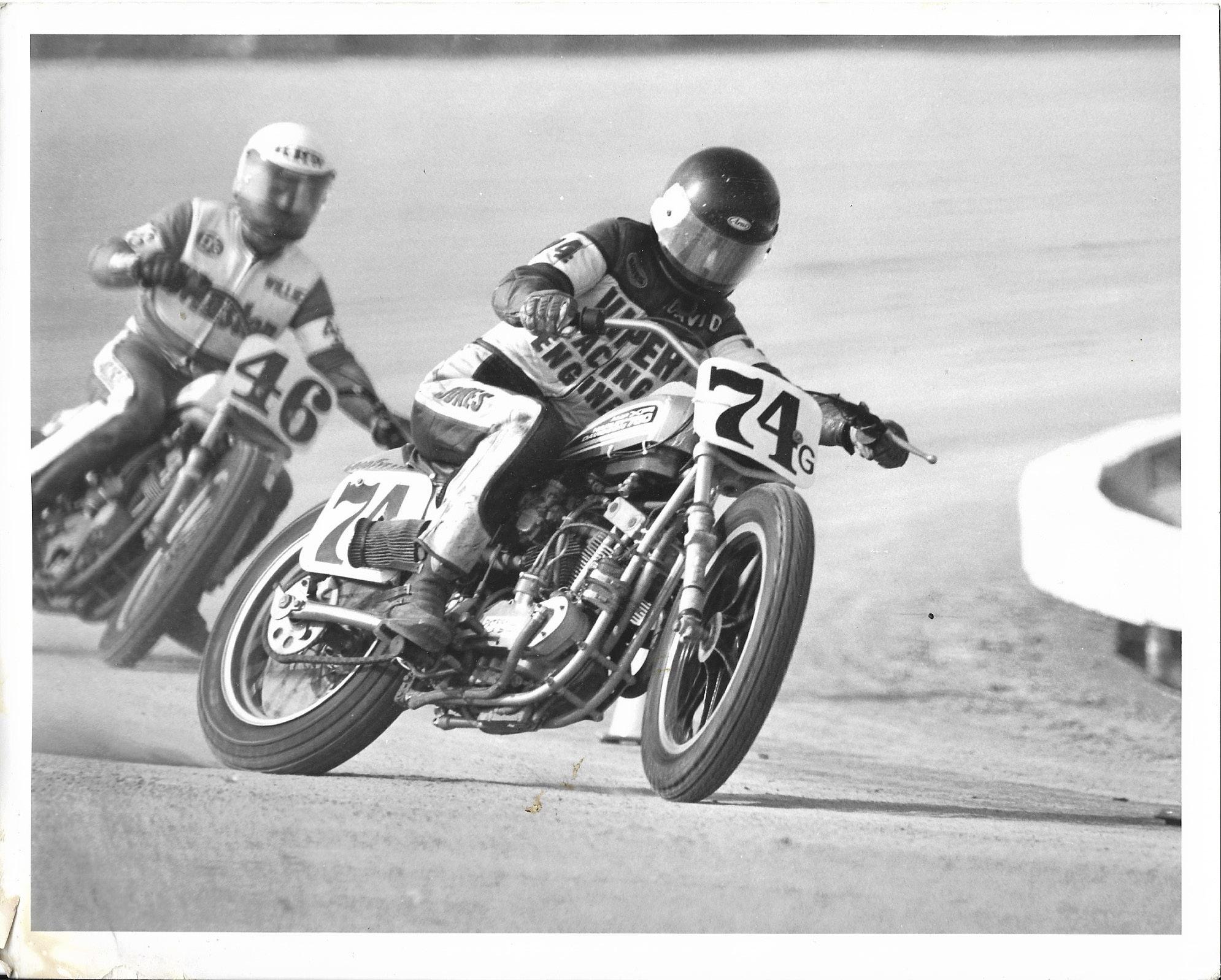





 Photos: Ronnie Jones archive
Photos: Ronnie Jones archive
1 4 5
21 With my brother David at rider introductions at the 1980 Houston Astrodome national. He would be killed later that year at Louisville. 2 Battling with Kenny Roberts in the Houston Astrodome Short Track, 1980. I went on to win my first national.


3 David holding the trophy after that first national win of mine. I’m talking to Scott Adams, in the red jacket with the blue and yellow cap. He would later become national #29 before being paralysed in a racing accident in 1991.

4 David at Louisville the day he was killed.1 Behind him is the late Willie Crabbe2 who would die after a crash at the San Jose Mile.
5 First lap of the Houston Astrodome TT in 1982. I’m number 16.
Appendix








1 According to the dairylandclassic.com memorial page, ‘[David] perished after colliding with a spectator who was crossing the track during a heat race of an AMA Grand National Championship event on the half-mile oval at Louisville Downs.’ 2 Again from dairylandclassic.com: ‘Expert-ranked Crabbe, 23, of Edgewood, Maryland, tangled with another rider and crashed in turn one on the opening lap of the fourth heat race for an AMA Grand National Championship event on the mile oval at the Santa Clara County Fairgrounds in San Jose, California, on May 11, 1982.’

23 >
3
6 Podium of the 1986 Indy Mile, celebrating with Ricky Graham and Scott Pearson.


7 Passing Scott Parker on the way to winning the Ascot Half-Mile national in 1990.
8 Sammy Tanner and myself. The first Ascot national winner and the last. Sammy won the first national motorcycle race at Ascot in 1959, and I won the last on 29 September 1990.
9 Podium at Oklahoma City Half-Mile 1991, after winning the Camel Challenge.
Appendix










The famous Ascot Park track, in Gardena, Los Angeles, lost its lease and closed in November 1990. The site was formerly a rubbish dump. According to Wikipedia it sat unused for years after the closure, after the original deal fell through, eventually becoming an auto auction and salvage yard. What a waste.

3
3
6 8



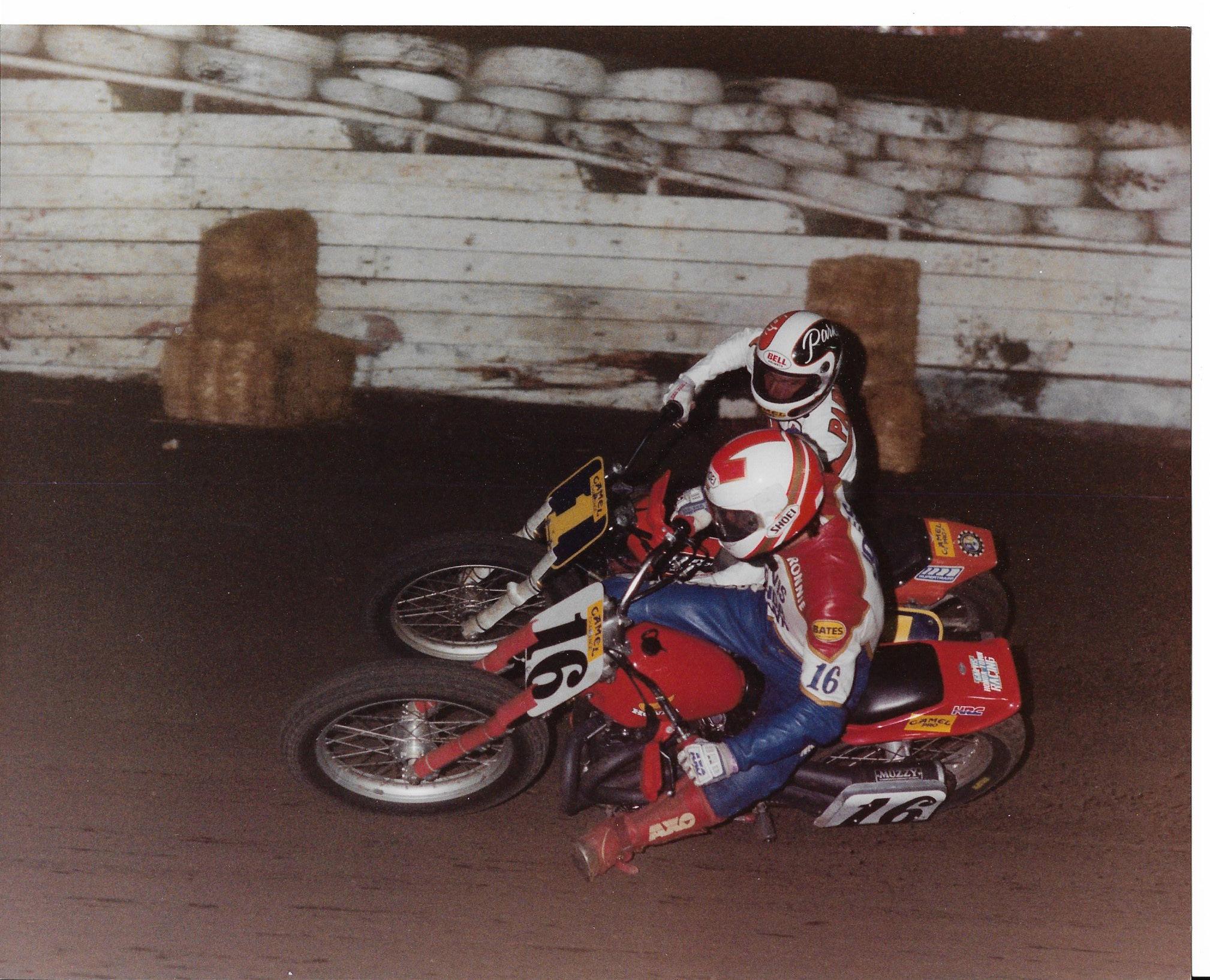
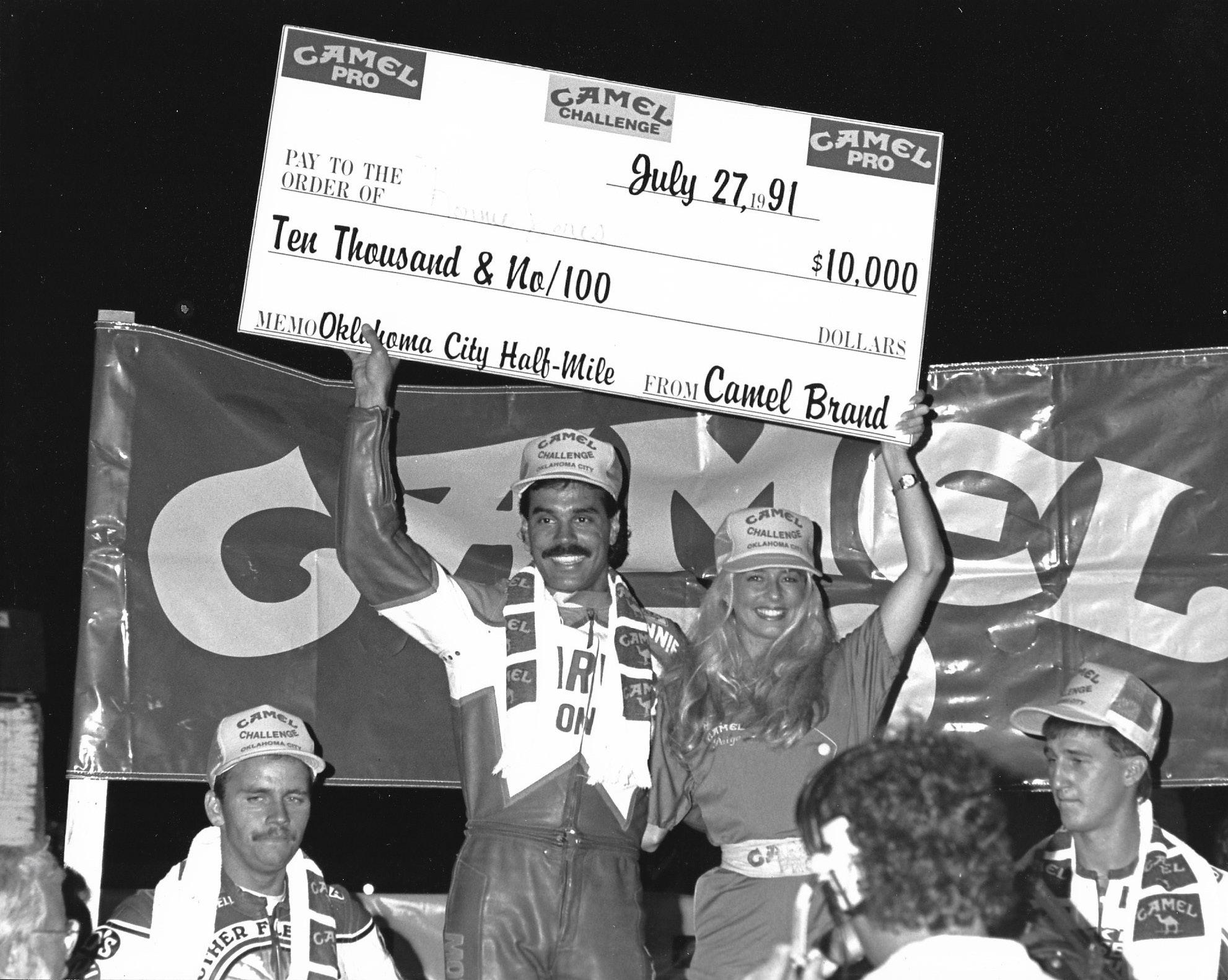



9 7



Get back to basics
PERHAPS YOU LEARNED the basics of flat track racing years ago. Maybe you’re winning races, possibly even titles, but that doesn’t mean you’re doing the basics right. At least according to Moto Anatomy’s Johnny Lewis. Johnny is a current racer and has won pro national flat track races and says he’s put more makes of bike in Grand National Championship finals than any rider in history. He is obsessed with the marginal gains and improvements that make the difference between success and failure on track. Johnny says even the very best racers benefit from refreshing the basics and banishing any bad habits that have crept in. Here’s his advice for Sideburn readers.
FIX YOUR FORM
When you first learn the basics of flat track, especially body position, you’re very conscious of them, but after years of racing you might begin to skip some, because you’re less aware of what you’re doing on the bike. The repetition of riding causes many people to do things like sitting too far forward and not realising why the front end is pushing, or sitting too far back and not understanding why the bike is moving around like a pogo stick. When people have these handling issues they often start changing their bike, when they could fix their body again and that would solve the problem. It’s something that pops up pretty regularly, even with some of the top riders who come to my school or buddies that I hang out with and watch them at the track or on fanschoice.tv. It’s important to be aware of what you’re doing on the bike and not rush into changing the set-up. You can fix, or cause, some big issues by adjusting your body form.
OUT OF BODY EXPERIENCE
Try to develop a way of visualising yourself as a third party, so you’re looking in from the outside. Is my elbow up? Is my inside arm straight at the apex of the corner? Am I looking where I want to go? Is my toe pointed to the inside of the track? When I’m coming off the corner am I rotating my shoulders back to get traction? Am I using the rear brake? Try to be aware of all that before thinking, This thing’s spinning up on the exit, let’s speed up the rebound to get better drive through the back of the bike. That will help, but it’s handicapping you a bit, because while it might work for that track, that time, that perfect scenario, if the track gets faster, because the moisture comes up, all of sudden you have too much traction, then what do you do? That’s what I teach: what to do when the thing is rebounding too quickly on the exit, or spinning too much. It’s having the tools to fix your body, because you can’t adjust the bike while you’re going around the track. Being aware of what difference your body makes allows you to make those changes.
LEARN TO OVERLAP
People underestimate the complexity of a fast flat track lap. Looking from the outside, people don’t realise how close the racing is. In road racing, the lap timea are 90 seconds to two minutes. We’re dealing with 15- to 36-second lap times and we’re sometimes within hundredths of a second.
On a flat track bike, you’re always overlapping actions and it can change from lap to lap. Let’s run through my
steps. First, you’re on the brake, dragging it on the entry to the corner while you’re still on the gas. Then you’re letting off the throttle, pushing the bike down, still on the brake, getting the bike leaned over. When you start picking up the throttle again you’re still on the brake to keep the bike settled and aid traction on the exit. All these elements are overlapping to keep everything as smooth as possible.
WRITE IT TO RIGHT IT
When I teach, I remind people it doesn’t matter if you’re a pro or an amateur, go back to the basics. Write them down and see if you’re missing something. From entering the corner to exiting the corner and even down the straightaway. Are you moving and transferring weight back and forward? If you’re not aware of what you’re doing on the track how are you going to relay information to a mechanic or know what adjustments to make when you come off the track? Don’t just listen to your bike – oh, the gearing’s bad, or it’s sliding on the exit – think how you were affecting it.
STOP THE SWAP
Swapping between bikes on a race day is one of the toughest things to do. The entry points are different, the weight of the motorcycle is different. Some amateur riders race a hooligan, a 450 DTX bike and a Honda CRF125 on the same day and that makes it hard to get faster. I understand some people just love riding, but it’s a decision to consider. I’ve ridden a bunch of different motorcycles and most of these bikes I sat on for the first time on the day of the race, before putting it into a pro main event. The first thing I do is make sure I can sit on them comfortably. Make sure the brake pedal is in a good position, make sure the bars are, too. If I’ve got the brake and the bars in a good position, nearly everything else I can make work, because I go back to the basics every time.
THE CAMERA DOESN’T LIE
It always helps to have an outside perspective. I love looking at photos of myself. If someone has a picture of me, I look at my form, where I was on the track, what I was doing, where I was looking... everything. I get very detailed. Is the back tyre squatting? I see what the bike is doing. I remember as a kid going to flattrakfotos.com and clicking through every photo and looking at the body position, where the riders’ legs were, where their eyes were, if they were on the groove, where their tyres were on the track...
CONTINUE LEARNING
The fundamentals are just that, but over the last couple of years riders have had to deal with bikes getting faster and the arrival of the Indian FTR750. I see really talented guys who are on bikes that aren’t as competitive and they overuse the rear brake to make the motorcycle work to maintain themselves at the top level.
I continue to learn by watching everybody and I put myself in other people’s position. I want to understand how other body positions affect the bike to get a different perspective. I put myself in my students’ position. If someone is riding with bad form, by that I mean bad body position, I ride like them to see how it affects the bike. They might get around the track fast, but they’re hanging on by their fingernails.
Words: Gary Inman in conversation with Johnny Lewis of moto-anatomy.com Illustration: Ryan Quickfall
29
Short brutal gnarly
We mean a lap of the Lima Half-Mile not Jared Mees or Shayna Texter…
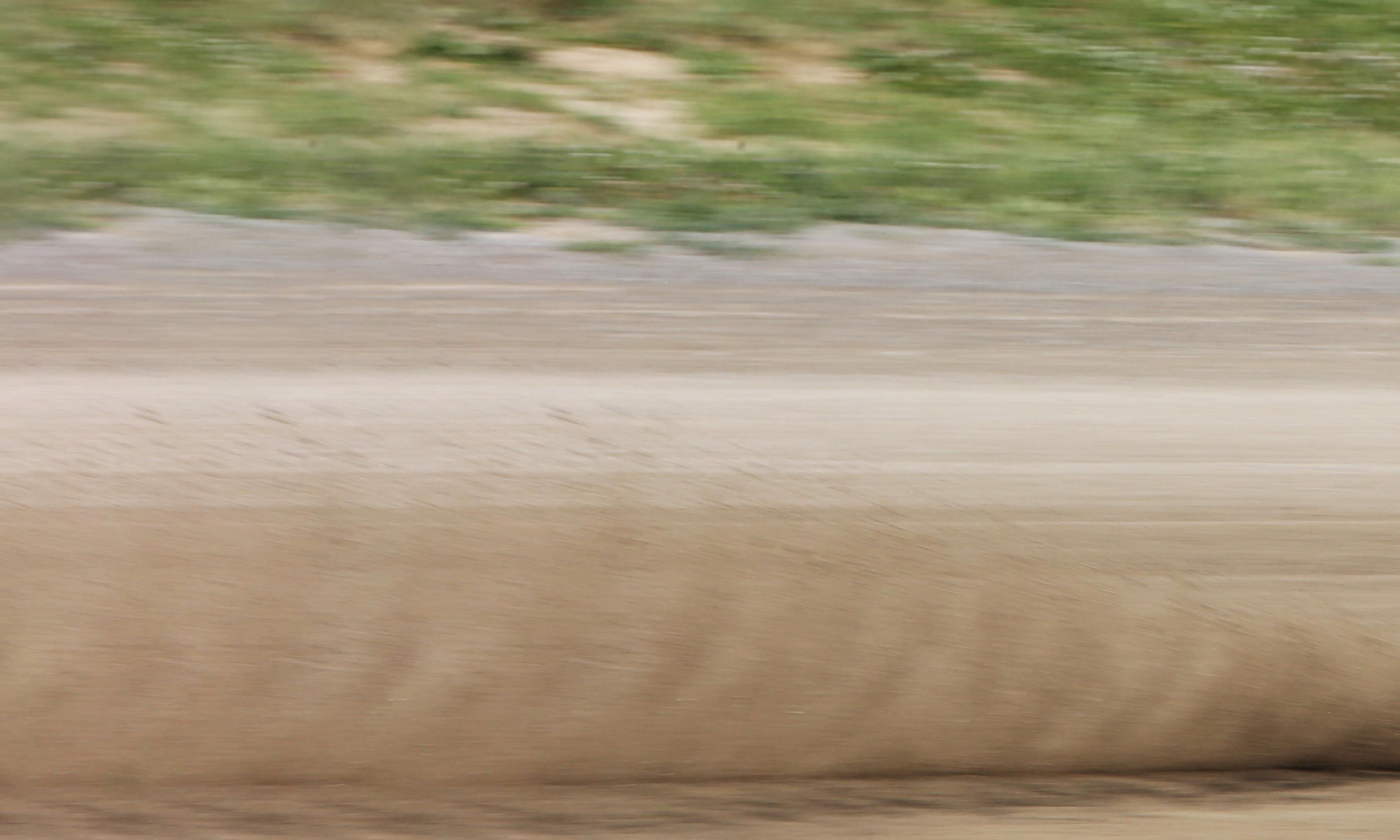
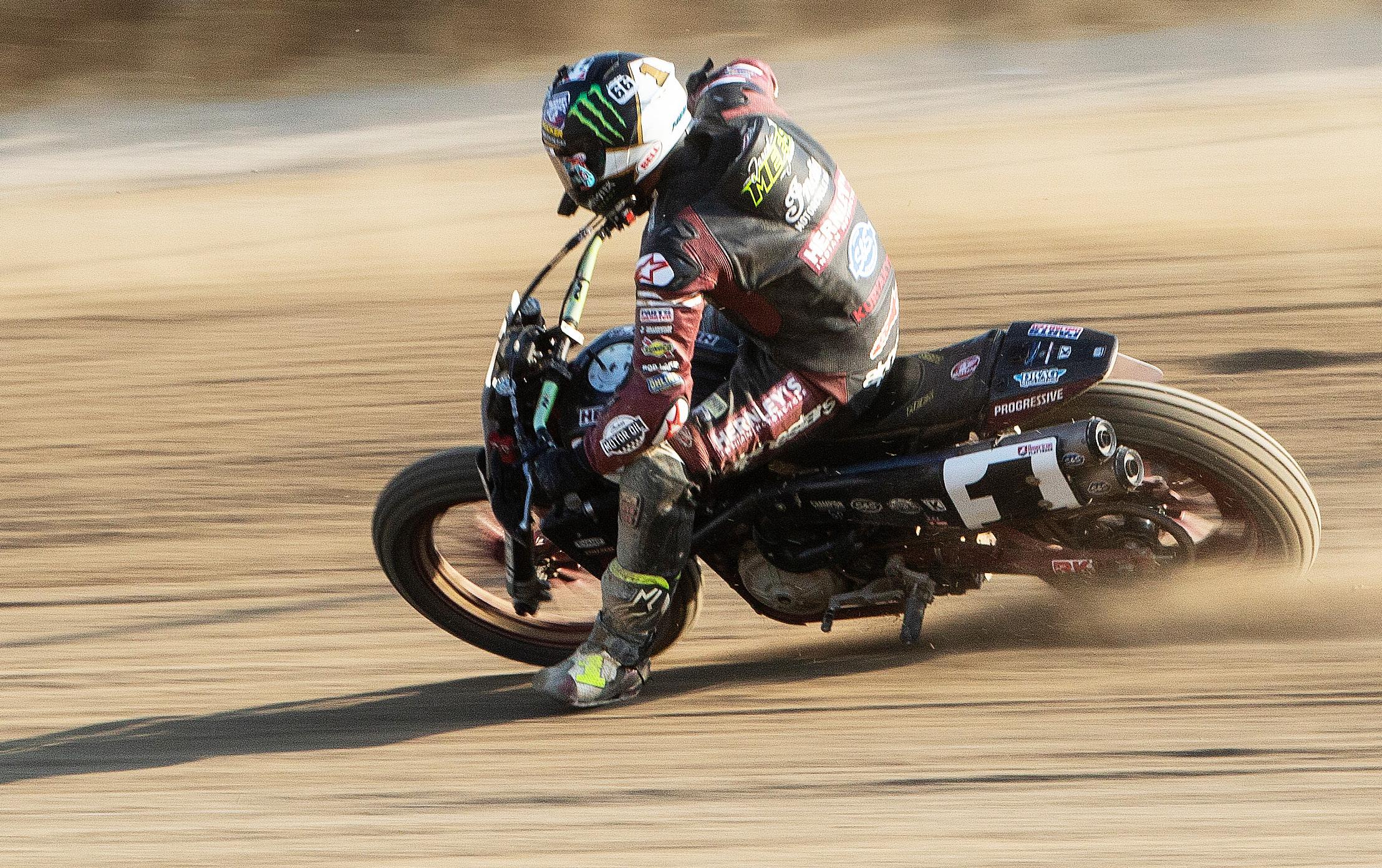 Jared Mees
Jared Mees
Words:
Gary Inman Photos: Ed Subias
AFT Twins reigning champ, tenacity shrink-wrapped in leather
Shayna Texter 5ft-nothin’ of preconception-busting, blonde ambition


> 31
LIMA, OHIO. ARCHETYPAL small-town America. 40,000 residents, a traditional fairground with a grandstand that isn’t so grand, and a dirt oval. A pea gravel oval to be more precise. Once a year the American Flat Track show comes to town. Teams from either coast of the States and many points in between, plus pro riders from as far away as Australia, are drawn to the rural Midwest, but travel five miles down the road to the charmless Stallion Bar in Harrod and the barman doesn’t even know the race is taking place. They can’t believe Ed the photographer drove seven hours from Wisconsin for the second year on the trot, never mind that I’ve flown from England, but for flat track aficionados Lima has an ultra-magnetic draw.
Ask the racers which their favourite track is, like I do, and none ever say this place, because Lima (and that’s Liema, not Lee-ma, this is Ohio, not Peru, sonny) is rough with a capital F. The roost that 100 horsepower of finely tuned twin spits up connects with enough force to knock a foot off a peg, and leaves biceps and unprotected necks looking like they’ve been blasted with rock salt from a sawn-off Remington. Unless they’re mummified under five pounds of thick, protective tape, bikes age five years in 20 laps or less. Springfield is repeatedly quoted as the race pro riders enjoy, but Lima is the one that gets the fans fizzing.
Even in the somewhat time-warped sport of flat track, Lima is an anomaly. Unlike new additions to the schedule, such as the Arizona Super TT on the outskirts of Phoenix,
Appendix
1 Mees has been three times a Twins champion, three times as combined Twins and Singles Pro/Expert champion. 2 The 2016 title came down to the final race, Smith on the Howerton Kawasaki, Mees on the Las Vegas Harley-Davidson. Both had four wins apiece. The season ended as Smith 240 points, Mees 235. Brandon Robinson was third with 182. 3 Indian has not specifically instructed S&S, who run the factory race team, not to modify the engine, but S&S principal Paul Langley says, ‘The engine underwent an extensive development program in 2016 and is very reliable and competitive in stock configuration’. 4 Nichole Mees, née Cheza, was a top-level Twins racer before retiring in 2015 to start a family.
Lima doesn’t fit AFT’s preferred location for growth. There are no urban conurbations nearby from which to draw a new generation of fans. Neither are there modern facilities to entertain corporate sponsors, but none of that matters because the true fans love, and support, the place.
‘A fit rider will win today,’ says Jared Mees. And he’s as fit as any flat track racer has ever been. The six-time champion 1 is part GrecoRoman wrestler, part honey badger. Though he is the spearhead of the Indian Wrecking Crew, and has been since the reborn brand’s reintroduction to pro flat track in 2017, he operates at arm’s length with an old, but incredibly experienced crew of grey-haired spannermen. Why? Because no one thinks harder about the business of flat track than Jared Mees. Being a satellite team under the wing of Indian Motorcycle, Mees gets to keep and cultivate his sponsors, including British apparel brand Red Torpedo, while benefitting from the accumulated knowledge of the factory team, run by S&S Cycle. But Mees also has Kenny Tolbert in his corner. As a tuner, Tolbert is currently unrivalled in the sport. He won an armful of titles with Chris Carr and has clocked up over 100 career wins as a tuner. At the end of the XR750 era, Tolbert’s Harley twins had been developed way beyond those of the Harley factory’s own. Tolbert’s version of the 40-year-old design had mutated, with external oils flows and pumps and God knows what else that no one else had tried. Together, Mees and Tolbert won the XR750’s last two Grand National Championships and missed a third by five points to Bryan Smith 2 before Indian signed Mees, Smith and Brad Baker for the 2017 season and the XR’s days were all but over. As yet, no one has won an AFT title on an Indian FTR750 except Jared Mees. While the factory FTR750s, ridden by the Bauman brothers, are obliged to remain bone-stock, 3 except for different cam profiles and exhausts that are swapped depending on the length of the track, Tolbert, and any privateer team running an Indian FTR750,
 Jared Mees, race day 9.30am, hustling, organising, focusing
Jared Mees, race day 9.30am, hustling, organising, focusing
is free to experiment with compression, porting, combustion chamber shape, piston manufacturer... anything within the rules and any grey areas they can think of. An abiding memory of the 2019 season is Kenny Tolbert rushing to his rider’s side with a domestic leafblower in hand. The race was the Red Mile in Kentucky, as hot as a summer’s day on Mercury, and Tolbert stood directing air over the highly stressed engine to bring its temperature down while a red flag incident was being dealt with. These two think about marginal gains more than anyone else. Will it make a difference? Maybe half-a-percent. OK, let’s do it. Not only is Jared Mees a relentless threat at just about every stop on the 18-round calendar, he’s also one of the promoters – that is, organisers – of the Lima Half-Mile. Along with his wife Nichole,4 the Mees put their money where their mouths are when the previous promoter stepped down in 2015. They’re not figureheads, pushed out in front of the media to sell the event, call the advance ticket phoneline and Nichole answers. Jared specifies and commissions heavy graders that are pulled behind trucks to groom the track between every session. Friends and family run the T-shirt booths and beer stalls. If no one turns up to spectate the Mees lose their money. But don’t read that thinking it’s less professional than any other race on the calendar, it’s up there with the best and when it comes to track prep it’s ahead of most, because Jared is calling the shots and no one is arguing with him. Knowing it’s the champion’s family effort makes Lima all the more special.

Walking through the pits, familiar faces ask if I’ve been here before. When I say I haven’t, they all tell me I’m in for a treat. That’s why I’m here. I walk onto the track and it’s not how I imagined. I thought it would feel like a wellpacked British beach, but it’s firmer and drier than that. As the first sessions of practice get underway in the early afternoon it’s clear the track is different to previous years. There’s roost, but it doesn’t have the same
consistency. What Lima still offers is the opportunity for riders to take wildly different racing lines and not be at a disadvantage. The Twins field could run laps until this time next year and it wouldn’t groove up.
Lima is one of the races on the 2019 calendar that is running all three pro classes: Singles, Production Twins and Twins. In each class, riders are experimenting with every line you can imagine, some swapping from lap to lap to see what feels fastest. Stay in tight to the apex between turn one and two; enter deep, turn hard and apex late; rodeo around the middle of the turns and, every fan’s favourite, WFO on the highline, touching distance from the airfence. Not only that, the fastest riders are treating the two ends of the track completely differently, going high and wide through three and four, and running much tighter through one and two. The sun is high, temperatures are in the mid-30s. The track takes its first high-profile victim before qualifying has even begun. Harley factory rider Jarod Vanderkooi is spat off mid-corner in practice. He gets tangled up with his XG750R and reports say he has a suspected concussion.
Despite there being countless permutations of racing line, qualifying in the Singles class is remarkably close. There are two timed sessions, and the track changes between both. The fastest times are set in qualifying session 1 (Q1), when the track is fresher. Chad Cose is fastest, Shayna Texter second.
‘SPRINGFIELD IS REPEATEDLY QUOTED AS THE RACE PRO RIDERS ENJOY, BUT LIMA IS THE ONE THAT GETS THE FANS FIZZING’
>
Nothing about Shayna’s exterior gives a clue to what she can do
Mees out front avoiding the roost, mid-corner, feet up, looking for traction. (opposite) Middle America fills the stands to watch the only woman in the race put on a masterclass


>
At the end of Singles Q2, 14 riders are within 0.5s of Mikey Rush’s 26.93s fastest time in the session. Consider that for a minute. 14 riders posted times on this half-mile of rough dirt within half-a-second of each other. If you have a stopwatch on your smartphone, try timing 0.5s. So yeah, it’s competitive.

But qualifying is one thing, racing is something else. And Shayna Texter is a racer. She was one of the riders within 5/10ths of a second of Rush’s Q2 time, tenth quickest in that session, out of 41 entries in the insanely competitive 450 Singles class. The riders are split into three heats, and, thanks to her time in the earlier qualifying session, Shayna gets to choose her starting spot on the grid.


‘The track’s pretty dry compared to normal
(clockwise from top left)
Great starts are important, but Shayna doesn’t always nail them this well; Gender stereotype reversal, no problem; The kind of slick pit AFT crave
Founded in 2007 and based in Glasgow, Scotland, Red Torpedo have had a long-running love affair with real road racing. They have sponsored riders, and made collections of T-shirts, with road racing legends including John McGuinness, Guy Martin and Dean Harrison. They have recently expanded into the flat track world and sponsor Jared Mees and Shayna Texter.

(top to bottom)
Mees in touch with the cosmos while the Wizard is spellbinding; Pre-practice, Kenny Tolbert with his arms crossed; The never-ending hunt for 0.1s
and we’re struggling with the gearing,’ Shayna tells me as she’s fitting dozens of tearoffs to her helmet visor in the KTM pit. ‘It’s not typical Lima right now. I wouldn’t mind if it was a little bit gnarlier. It’s normally rough and wet. It’s mind versus what your throttle hand is going to do. Your butt is bouncing off the seat and you’re definitely moving around a lot more on this type of surface than a clay half-mile. You’ve got your hands full. It’s definitely a lot more physical, but we’ve grown up racing on these horse tracks, it’s kind of second nature to adapt to them.’


I’ve met Shayna a few times over the years, but it’s still hard for me to get over how petite she is. And the track isn’t gnarly enough for her? She is extraordinary.
I take the opportunity to watch each session from a different point around the track, regularly dowsing myself with Hawaiian Tropic. For Shayna’s heat race I’m tight to the rickety fence on the back straight, just an old chain link and some flaking planks of wood between me and the track at this point. Health and safety hasn’t diluted Lima’s fan experience yet. As for the riders, airfences are only in the corners, and the straights don’t even have haybales. It goes without saying she is fully committed coming off turn 2, but to witness what that looks like is sobering. Feet up, bike dancing, the 5ft-tall rider being bounced about like a flea on a dog’s ballsack, all while 13 other riders, including Gauthier, Whale, Dean and Dallas Daniels, hunt her like beagles after a fox.
For her semi I walk around the outside of turn 1 and 2. As the grid forms, a friend asks me who I think is going to win the eight-

>
‘OF THE 17 RIDERS LINING UP, YOU WOULDN’T LOOK FOOLISH FOR TIPPING TEN OF THEM FOR THE WIN’
lapper. The front row is stacked. Shayna plus current number 1 Bromley; Rush; Wells... The lights change and I see Shayna launch. Before her rear Dunlop has crossed the startline I say, ‘Shayna’. She does, with a gap of 2.85s from her KTM team-mate, Bromley.
For the Singles main I sit in the bleachers on the back straight, directly opposite the grandstand. Shayna gets the biggest cheer of the night from the packed grandstand when she is introduced to the crowd. She gets a bad start and is eating the dirt of four or five of the very best and hungriest Singles racers in the game. I would give both little fingers and a kidney to be able to do what Shayna did over the next couple of laps. She takes Gauthier on the outside – her handlebar ends are so close to the fence it makes me cringe. Within a couple of laps she’s out in front, skimming over the rutted dirt. Every now and then the Ohio pea gravel gives her bike a slap and the rear end jumps a foot to the right. She doesn’t back off. Of course she doesn’t. If she backed off every time a place like Lima gave her a slap we’d never have heard of her. By half race distance she is so far ahead of the pack her roost isn’t even hitting the bike behind.
Plenty of people point at her size and weight as if to say, of course she has an advantage. I understand the bald physics of the statement, but it’s so ignorant of what it takes to win a race like the Lima Half-Mile it’s laughable.
In the dusty bleachers a group of fans in their 60s, V-twin riders in Harley and Indian shirts, who admit they haven’t been to a race since Jay Springsteen was a regular, have been stood up for the whole race. One turns to me, ‘Hey, was number 52 a girl?’ ‘Yes!’ shouts the woman in front of me before I have chance to open my mouth. His eyes widen. ‘Cool!’
As Shayna collects her trophy I walk to the fence on the outside of turn 2 for the Twins main. The top of the airfence has a layer of dry gravel sat on it. Not a good sign, but perhaps I’ll be OK. Of the 17 riders lining up, you wouldn’t look foolish for tipping ten of them for the win. Jeffrey Carver and Briar
Bauman won their semis, both on Indian FTRs. Mees was second to Carver.
The main is 25 laps, less than 12 minutes of racing. The lights change and the 17 riders arc through the corner displacing 100lbs of gravel, some of it peppering the fans on the fence. We’re like kids in the splash zone at SeaWorld, but most of the people I’m stood among are middle-aged, or older, and laughing as they swivel away from the spray. None of them switch positions. This is my kind of interactive.
Bauman is out front. Mees, Jake Johnson on the Yamaha and Henry Wiles close by. After seven laps the red flag comes out. Three laps after the restart Bauman’s rear rim spits its tyre off in a way no one had seen before. The 15 or so laps that follow are the best flat track race I’ve ever seen. Carver hunts down the reigning champion, and the pair criss-cross at 90mph as their wildly different racing lines intersect 20 metres in front of me. Henry Wiles edges nearer to the battle. He’s close enough to be pebbledashed by the pair in front, but never quite able to make a move.
Carver passes Mees, then Mees fights back. Lap after lap. Romantics think the Wizard has a spell up his leather sleeve. Realists have already given the checkers to the Jammer. With two laps to go, Carver’s Indian starts to smoke, but it’s a coolant pipe not the engine. His team pray he won’t be blackflagged as the last lap white is waved. An orbit of Lima takes these pros less than 27 seconds, enough time for two more passes. The crowd is freaking the hell out.
The difference at the line is 0.199s. The champ, the Terminator, has done it again and he takes Nichole, the person who would answer the phone if you called for a grandstand ticket, and his toddler daughter on the victory lap. It’s a Hollywood finish.
Carver tells me the race ‘was like two guys arm wrestling for 24 hours and asking themselves, what are we doing here?’ He adds, ‘Jared was just more in tune with the cosmos tonight.’
The pits are buzzing with people telling each other what they just saw.
That number 1 plate is heavy on a hot Midwest night, but Mees can shoulder it. The contenders can stay hungry
‘When you’re battling up in the cushion like that, it wears you out twice as fast,’ Mees explains. ‘You’re wrestling the bike, and the bike’s jumping around. Hats off to Jeffrey; I work out so hard, and I didn’t have nothing left. I was done. I just want to give a big shout out to Jeffrey and Henry for a hellacious, awesome race.’
Hats off. It was hellacious.

>
What must this feel like? To beat the best in the world, on a bike equal to those around you, on a track seemingly designed to punish



Made in the USA • sscycle.com • @sscycle 2:2 Hooligan High Pipe made for your HD ® Sportster ®
substance never goes out of style. ................... ................... ................... ......................................................... The Gringo™ is a low-key, high-performance helmet that looks as good as it works. Meets DOT & ECE Regulations / XS-XXL Sizes / Ten Colors WWW.BILTWELLINC.COM @BILTWELL
 Gloss Sea Foam (New for 2019)
Gloss Sea Foam (New for 2019)
Some thing d ifferent
Mike Hill of Survivor Customs Racing won two national championships on Rotax singles, then set himself a new challenge
Words: Gary Inman Photos: Tom Bing

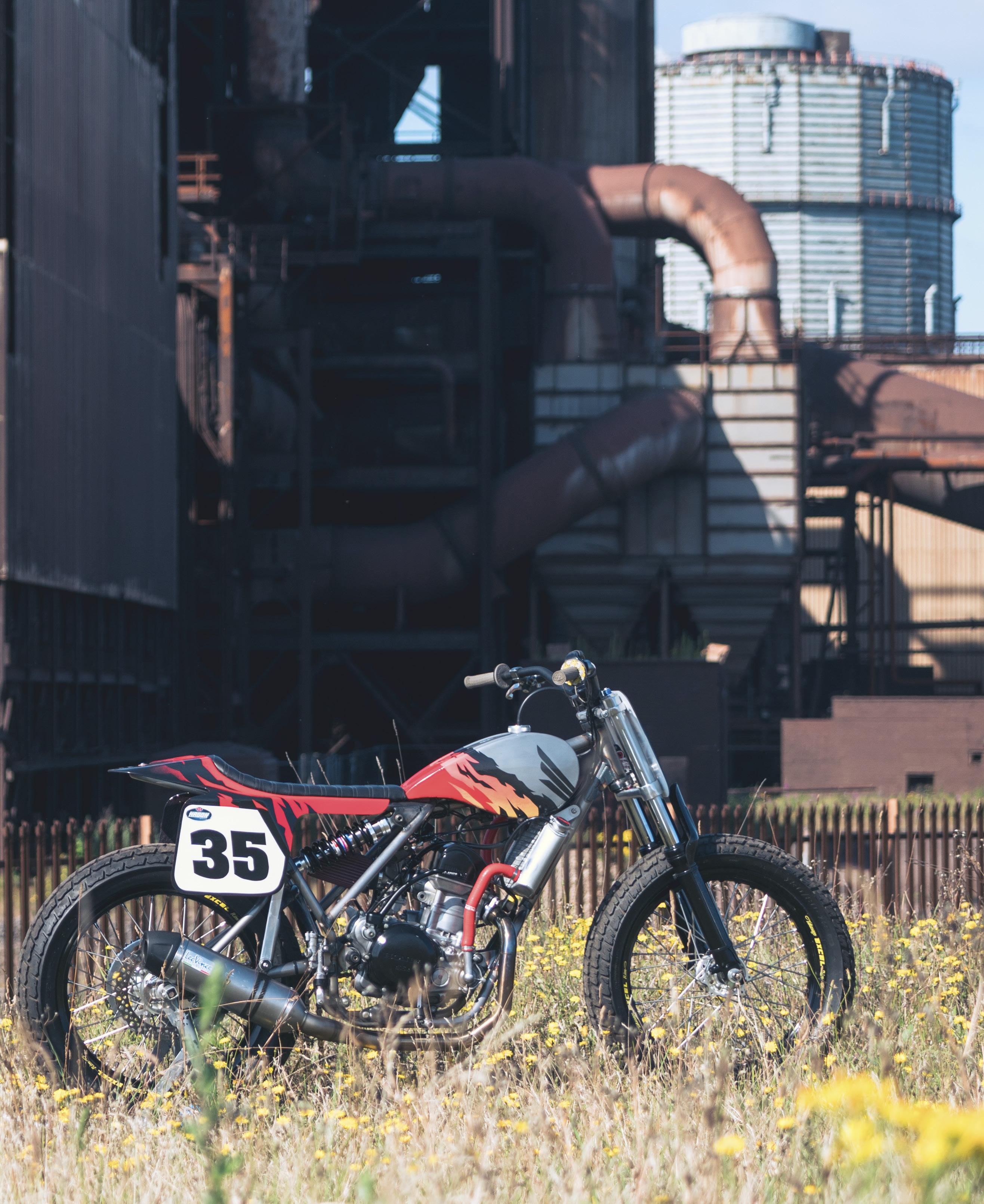
45 >
o, 94kg = 207lb = 14st 11lb. I include stones because I’m British, that’s how we refer to our personal bulk so I find it easier visualising a 15-stone person than 94 bags of sugar. Americans can imagine a 200lb person pretty easily.
That’s how much Survivor Customs say their new Lightning CRF450 weighs. Not very much. In fact, if their scales are accurate, it’s 10kg – a whole 22lb – under the lower weight limit for American Flat Track’s Singles class. In comparison, Honda claim 112kg/247lb for their 2020 Honda CRF450R in race-ready motocross trim, just waiting for petrol. And that is the cutting edge of showroom ’crosser.

Mike Hill, of Survivor Customs Racing, set out to practise what one of the greatest ever F1 designers preached: ‘Simplify then add lightness,’ said Lotus founder, Colin Chapman.
From a distance I watched the bike grow, like a bridge across a broad river, or a spider spinning a web. A very disjointed but compelling time lapse. On my phone screen, new frame tubes appeared, tacked in position. 4130 chromoly spars and spindles came together looking quite unlike any flat track frame I’d seen before. When a compact 2006 Honda Unicam four-stroke motor was in position, virtually sat on the bottom rails and nothing
(below) Regular contributor, and Mike’s mate, Ryan Quickfall painted the bike. Chromoly frame is clear coated
else around it, the steering head tube looked like it was in a different postcode. The single downtube isn’t unusual for a modern flat track frame nor the way it splits into double bottom frame rails after the front engine mount, but the engine is low and way, way back in comparison to the front wheel axle, making the swingarm short within the desired wheelbase.
Like any chassis builder, Mike started with a rough idea and definite measurements. ‘I wanted to build something different and asked Ollie and Derek Brindley1 to send me dimensions of bikes they measured at races in America and I printed off a load of side-on pictures of flat track race bikes to compare them. I also had an old Champion frame, built for a four-stroke Yamaha single, in the workshop.’
When Mike says he wanted to build something different, he means not only to what else was out there, but also to what he’d built before. Survivor’s first foray into the flat track world was modifying Rotax-powered road bikes for the UK’s Dirt Track Riders Association championship. He built one for himself and loads for customers (see SB34), then went further by cutting more and more of the frame away and replacing it with his own tubes until not much original was left. Survivor started by twin-shocking monoshock road frames. With time,
Appendix
1 Oliver Brindley is the only British rider to currently compete as a pro in the American Flat Track series. His dad, Derek, is an engineer and former world champion road racing sidecar driver.
>


‘It’s quite forgiving. If I pushed the Rotax this hard I wouldn’t stay on it’

>
Mike developed his idea and embraced monoshocks, but with the shock position moved entirely from where it was on the road bikes.
‘I wanted the Lightning to be a modern version of an old-school frame like the Champion that I had in the workshop. It has a steering head angle of 26 degrees so I steepened it up. I raised the seat rails 1.5in (37mm). I looked at the Indian FTR750 a lot.’

The crucial measurements of a chassis are quite obvious: wheelbase, head angle, shock length, swingarm length, but Derek Brindley made it clear that Mike should consider the relationship between the engine’s output shaft and the swingarm pivot very carefully. ‘I also wanted to get the crank as low as possible. That’s why the engine is so low and tipped so far forward,’ Mike explains.
The engine choices were either Kawasaki or Honda, but there are many more Hondas in circulation, and also in the DTRA paddock, so going red made sense. The engine remained standard except for a K&N air filter on the carb, an exhaust header Mike made and a used Leo Vinci road bike end can he bought online.
There are few more self-sustainable race bike builders in the game than Mike. He built the frame then fabricated the tank from 2mm sheet alloy. The seat unit is his own design and mould, as are the fork protectors, both products he sells online. One of the many differences between his previous Rotax race bikes and this new(er) Honda framer is that the Japanese engine is liquid cooled. ‘I ordered a radiator but they said it was going to be two months, so I bought a core and made one myself. It was much easier than I thought it would be.’
Yamaha R6 forks and triple clamps and 19in wheels were bought secondhand and ProTaper FT bars were imported from the States. Then it was time to test and enter some races.
‘I wish I’d ridden a DTX bike2 between riding this and the Rotax because it was one extreme to the other,’ says Mike, admitting he struggled to adapt to the featherweight 450. ‘I needed to trust myself to brake later, go deeper into the corner, and I had to get used to the engine too.’
Then disaster, the used motor Mike had installed stopped dead. ‘The bottom end nipped up. When I stripped it the oil pick-up was full of silicone sealer someone had used when they rebuilt it.’
The engine was rebuilt and Mike took his Lightning to Greenfield Dirt Track (see p90) to test, become more comfortable and build more of a relationship with the bike. The two-time national Thunderbike3 champion had left that category to race in the Pro class with the very best in Europe.

When we spoke about the bike, Mike was getting to the point where he was ready to start making frames for other racers. He had changed the Hagon rear shock five
The static photos were shot in front of British Steel’s blast furnace, where Mike worked as an apprentice among rivers of molten metal
times to get the feel he wanted and admitted he’d been fighting the chain run and swingarm, but the theory was close to being proven. ‘It’s quite flexible and forgiving. If it gets out of shape or you start to lose the front end you can stand on the floor and straighten it out. If I pushed the Rotax this hard I wouldn’t stay on it.’
The very next day, DTRA Pro race winner and Hooligan champion Gary Birtwistle and George ‘Greenfield’ Pickering tested the bike at Rye House and gave it the thumbs up, so Mike is ready to build chassis for patient customers who’ve been waiting.
On the surface, a flat track frame is simple. Round tubes and fabricated plate, but there are secret ingredients that make the finished product delicious or inedible. This sport, at an amateur level at least, has too many people who are willing to rip off the pioneers and established builders, people who have put years, decades, into learning what works. Even as I write this, people are making exact copies of others’ designs and passing them off as their own. Survivor Mike hasn’t done that. He’s been brave and done something different.
2 A DTX bike is a 450 motocrosser lightly modified for flat track. The wheels and tyres are swapped for 19s, suspension is lowered, sometimes exhausts are changed for low, under-the-frame style pipes. 3 The DTRA Thunderbike class is for four-stroke framers 600cc and over and modified road bikes.
Appendix
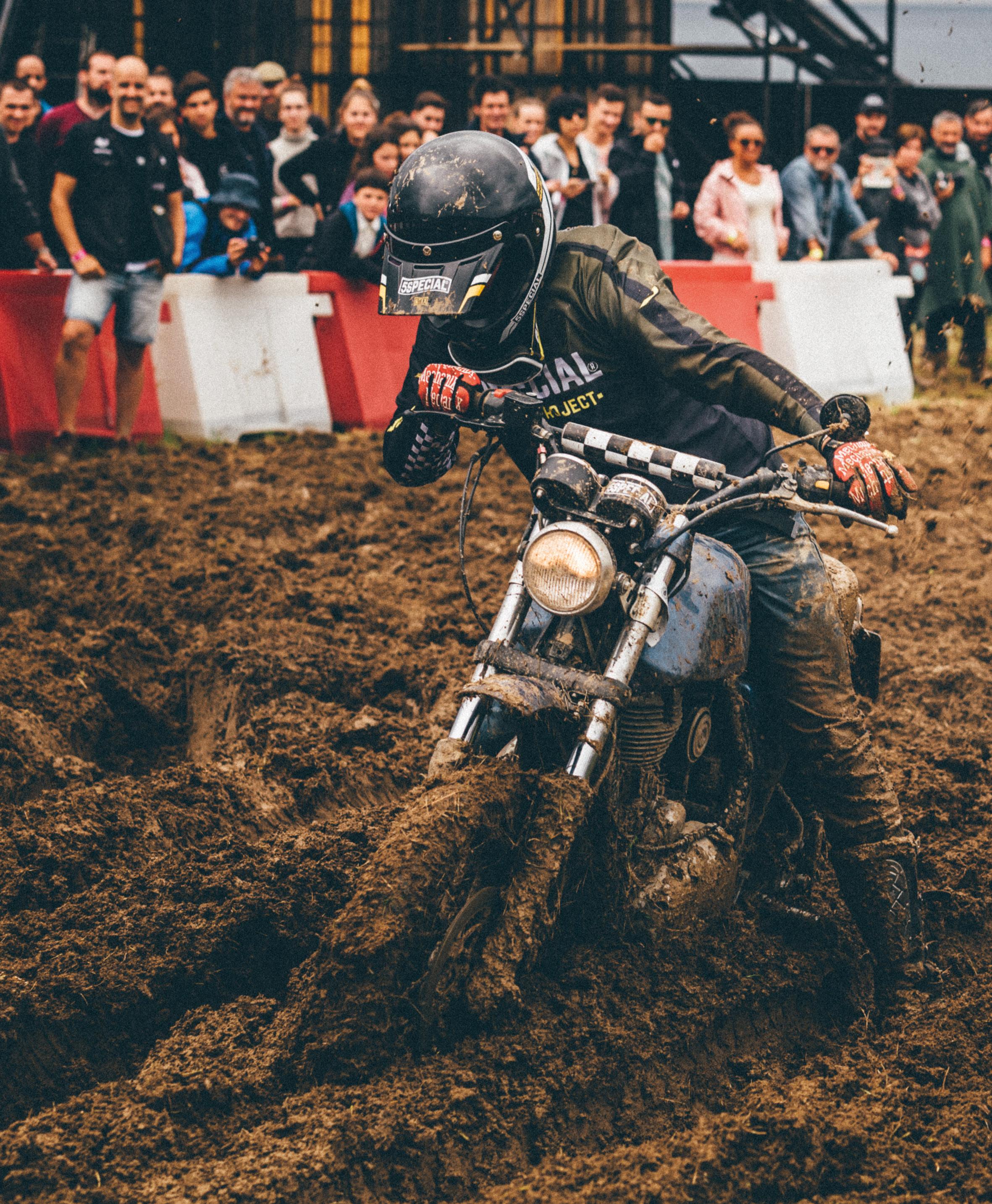

wicked winch

Problem: The motorcycle workshop is on the third floor and there’s no lift… Words: Westley Agius Photos: Caylee Hankins
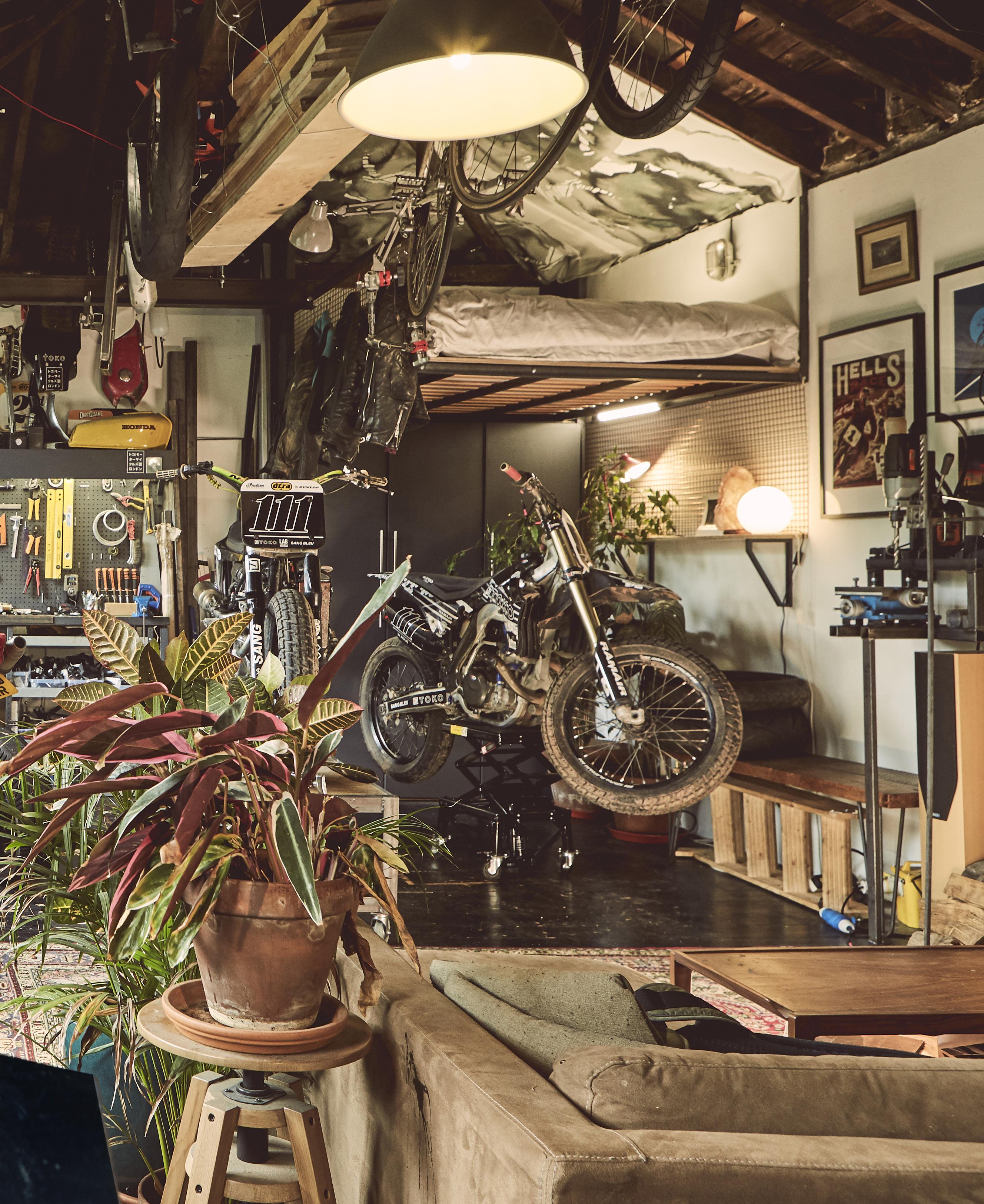
53 >
IT’S IMPOSSIBLE TO find a ground-floor workshop where I want to live in London. I could find somewhere on an industrial estate, but I didn’t want to live on an industrial estate. After two years of searching I found this place. There used to be a florist’s on the ground floor and the owners used this place to store parrots and lovebirds they rented out for weddings. It was covered in shit and had mice everywhere because of the bird seed. I ripped it all out and built a work/ living space in it.


I’m a lighting gaffer for film, TV and commercials. I also make furniture and fit out studios, so I designed, made and installed the winch and the cantilever arm that swings out. It’s built well over spec, with plates anchored to the wall and two-ton beam trolleys that run along the joist. I had a head rigger I work with check it before I used it, but I was still nervous the first time I had a bike hanging from the winch. The building is a Victorian factory and I was imagining the whole corner of the building crumbling and falling off.
I started racing flat track because I used to be into racing 1000cc superbikes around London. I had a big bend-up on my Aprilia RSV1000 on Shepherd’s Bush roundabout at four in the morning and put myself in intensive care. After 11 months I was walking again, the bike was repaired and I went out again, had a near miss with a truck and thought, What am I doing?


I’d heard about flat track and there was a race at Rye House, the nearest track to me, so I went along and had a look. I remember seeing Jon Bell on his orange Yamaha 500 in matching leathers, flying into the corner sideways and thinking, That guy is the geezer! This is sick! Now me and him battle. That makes me proud.

>
When workshop and living space collide. Westley at one with his surroundings




‘Wes! Wes! Me bike’s been nicked!’ High jinx can take on a more literal meaning in this London street
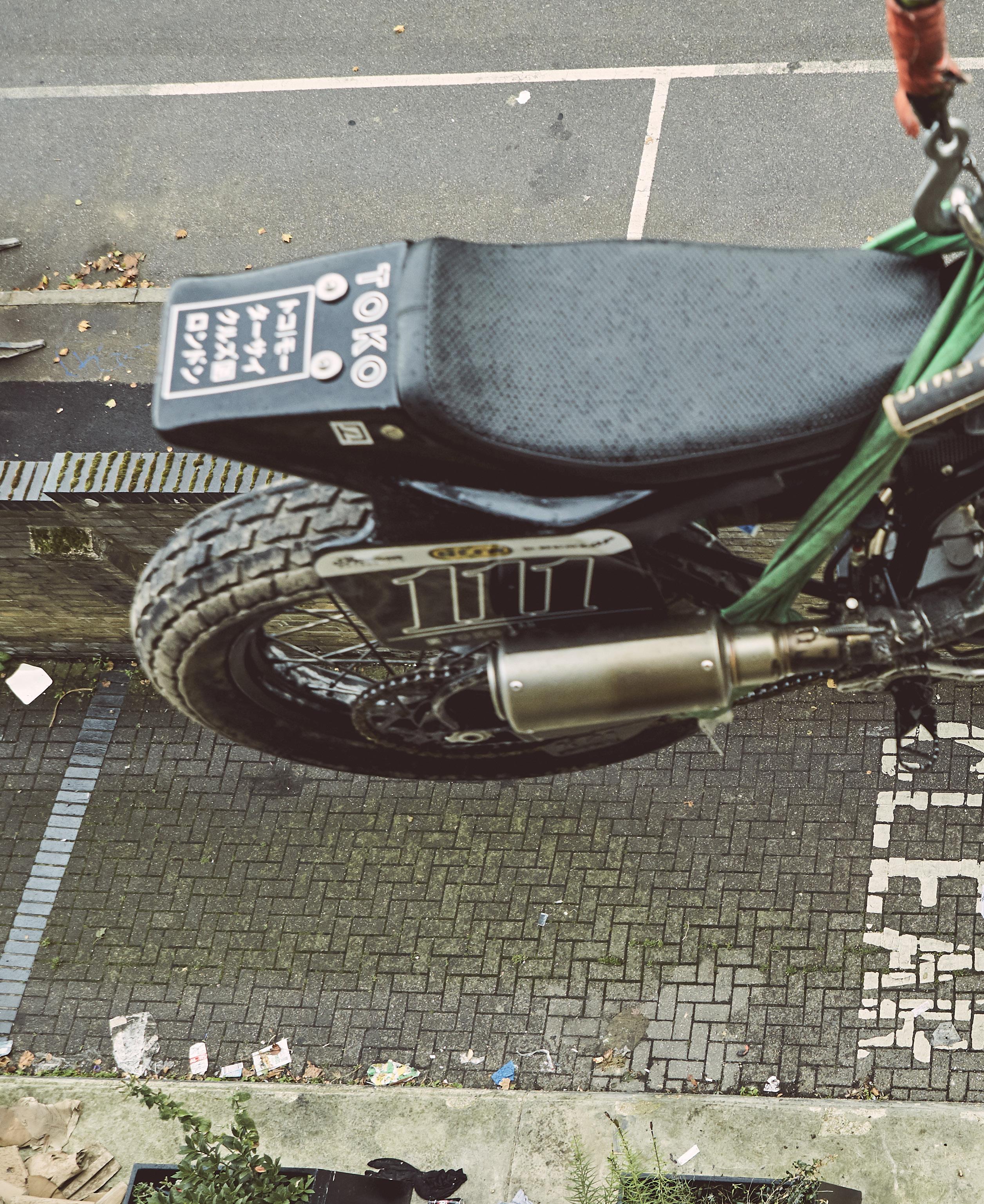

>


>I knew I wanted to build a Thunderbike, and saw that a lot of people used Rotax motors, but I was always a fan of KTMs. This LC4 is from 2005, so it’s old, but it was the supermoto to have back then. This year and model was special. It’s a 660, not a 640, and came with a bigger pumper carb. It’s top spec and quite a weapon. The big thing with these engines is cooling. I had a two-radiator set-up, but I broke the top one three times in crashes. The bottom one was always fine, but then it got a hole. This side radiator is just temporary.
The bike has a custom ignition ECU made by Racetech Developments in Towcester. The engine is carb, not fuel injected, but I have four different ignition maps and I can swap between them with a switch I fitted on the handlebars.
I made the subframe and the swingarm with the brace and fitted a Penske shock. It’s direct, no linkage, and even though I’ve changed the springs and the valving and had it on a shock dyno I think I’m going to swap back to the previous set-up.
I’ve gone from the buzz of racing on the road to getting kicks from the progress I’m making in racing flat track, trying to find two-tenths a lap and working on making this bike faster and more stable. And the community is wicked. In my first season I missed out on winning the championship by one point – and I broke my hand that season.
 Beanie
Beanie
hat? Check. No socks? Check. You’re good to go
Flying 57
Italian custom builder Plan B talks tight fits, loud music and an airborne Chevy pick-up
Words: Mick Phillips Photos: Omar Rosa
IF IT WON’T GO, don’t force it. You can’t get a quart into a pint pot. Shove that in there and summat’s gonna split. All well-known sayings (OK, maybe not that last one, which might have come to me in a dream) and all completely ignored by Christian Moretti, aka Plan B Motorcycles, who likes few things better than a challenge.
In this case, the challenge arrived at his workshop as a compact and spindly frame from a 1957 Bianchi Tonale 175 and a hefty Rotax 560 engine.
‘The customer wanted that engine inside that frame,’ says Christian. ‘Yes, there are a lot of crazy people out there and I was lucky enough to have one of them knocking at my workshop. The style came naturally around the hot rod idea of that big engine wrapped in the small bicycle-like frame.’

Christian calls his creation a ‘moonshine’ racer, a distillation of various elements. And just like a greedy slug of methanol-tainted barn-cooked grappa it makes your heart thump and a daft grin spread across your gurning-idiot face.
‘I had carte blanche and the style came in a very natural way when I forced the engine into the frame.
>
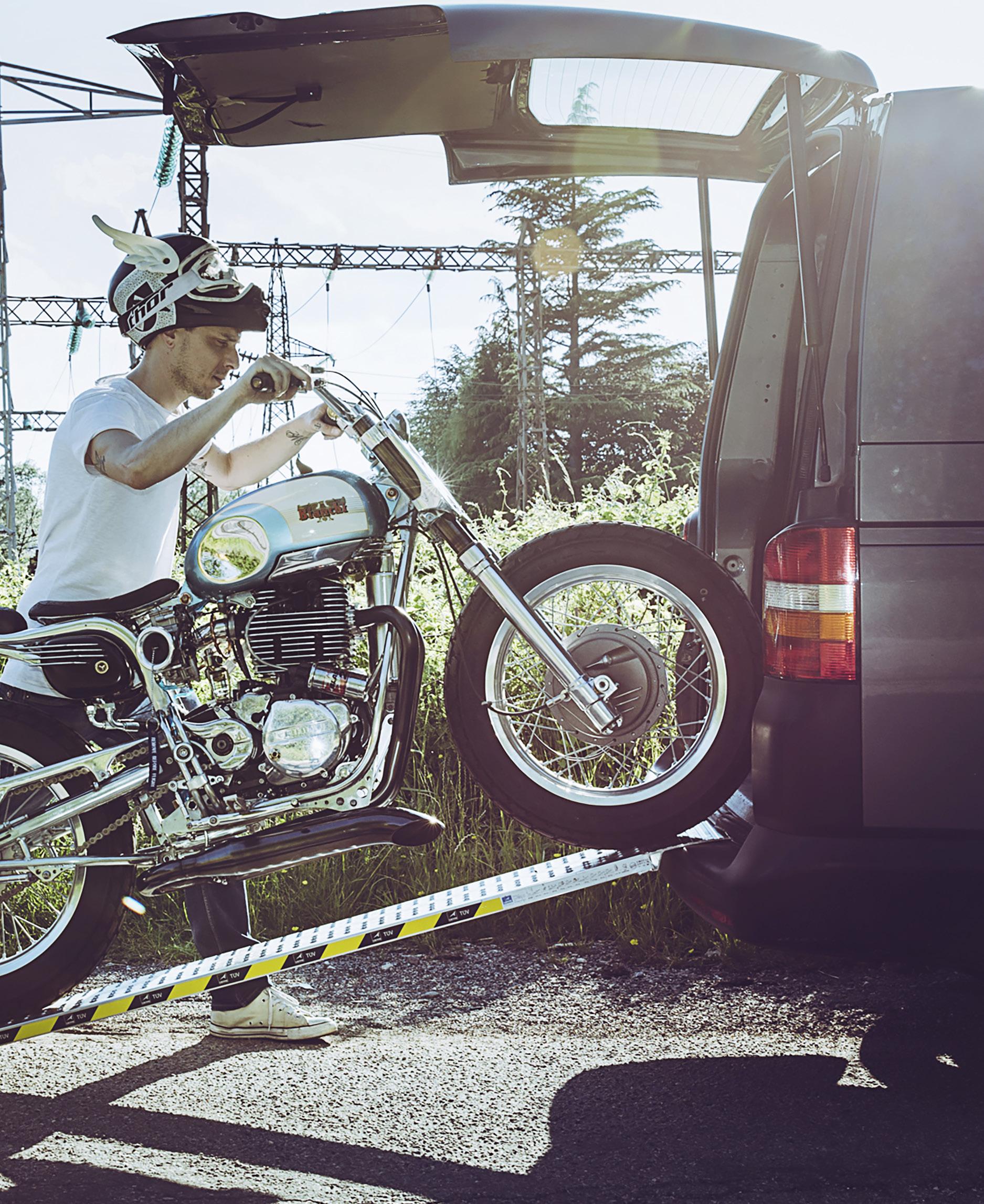
61
The proportions, the lines, the engine moved the project in the tracker direction. It’s inspired by the hot rod movement of the ’50s and ’60s, by outlaw sprint car races and by the pre-chopper scene.’

That name, though. Flying ’57.What’s the story? ‘I want it to be, in a way, an homage to Mark Madson’s crazy Truck in a Tree installation1 and that’s why Flying ’57. Hopefully, it will not end up stuck on top of a tree, but let’s just say that riding this thing can totally lend itself to a similar scenario...’
Christian operates out of his workshop in the small northern Italian town where he was born and grew up, Laveno-Mombello, on the shores of the stunningly picturesque Lake Maggiore. But the 36-year-old doesn’t quite fit the sleepy surroundings, building highly-crafted specials while listening to banging music or taking a break on his drum kit.
‘I studied as an electrical engineer at high school. After graduation I decided to study philosophy at university. To put it in a family-friendly way, those were three psychedelic years. I never finished university, but in the meantime I graduated as a sound engineer and worked a bit at concerts and recording studios, but because I wanted to be a rock star, I didn’t like being on the other side, so I started jumping from one job to another until I ended up in a factory working as an apprentice on the lathe. Hated the job, but I discovered that I could make parts for my old Mini during lunch breaks and that’s where my love for the mechanical work started.’
It’s a love you might argue has developed into an obsession that manifests itself in the creativity and solutions lavished on this project. After 700 hours’ work, Christian stopped counting. Those hours brought out some great touches. But, going back to the matchup between that weedy frame and the Rotax lump, something had to give.
‘Only part of the front section of the frame is still there, all the rest was custom built, reinforced or modified to let the new motor fit. The upper part, from the neck to the end of the gas tank, was boxed to create the upper fitting for the front-mounted rear shock. The rear section was raised 70mm and then cut to end up in a classicstyle loop. The bottom part was made from scratch to accommodate the Rotax engine and the Kawasaki GPZ swingarm, mounted upside-down. Everything was then zinc coated and hand polished, leaving some of the original marks and patina of the 60-year-old frame.’
He’s a big fan of Kiwi genius-engineer John Britten and his V1000 race bike, which shows in that decision to forward-mount the rear shock.
‘Britten is my favourite superhero! The shock mounted
In 1994, Madson placed a 1959 Chevrolet Fleetside pick-up in a forked tree in his hometown of Clinton, Wisconsin, as a treehouse for his son. It’s still there.
> Appendix 1
Flying ’57 basks on the shores of Lake Maggiore. Exposed cam belt gives that blown hot rod feel

in that position is a small tribute to the bike and the man. It was also a way – together with the strangelooking exhaust – to try put all the weight in the middle of the bike, which ended up an almost perfect 50-50 on the wheels at 110kg. Designing a functional linkage and making it fit between the engine and the exhaust was quite tricky, but fun at the same time and allowed the use of the under-seat space for the oil tank and the all the electrics. It’s kind of rewarding now to look at how the linkage works and think about all the tests and mock-ups needed to get there.’
Christian likes being on his own in the workshop, with good music for company, and takes on almost all the work himself.
‘As they say, I do all my own stunts. I love working alone and I do everything by myself except for the paintjob – for now. Obviously, I don’t know everything there is to know, but what I don’t know I try to learn –asking, searching and studying as much as I possibly can every single day.’
So, what next from Plan B? A CBX motor in a Tiger Cub frame? An XR750 engine shoehorned between a Hummer’s squealing tubes? Whatever it is, we look forward to it.
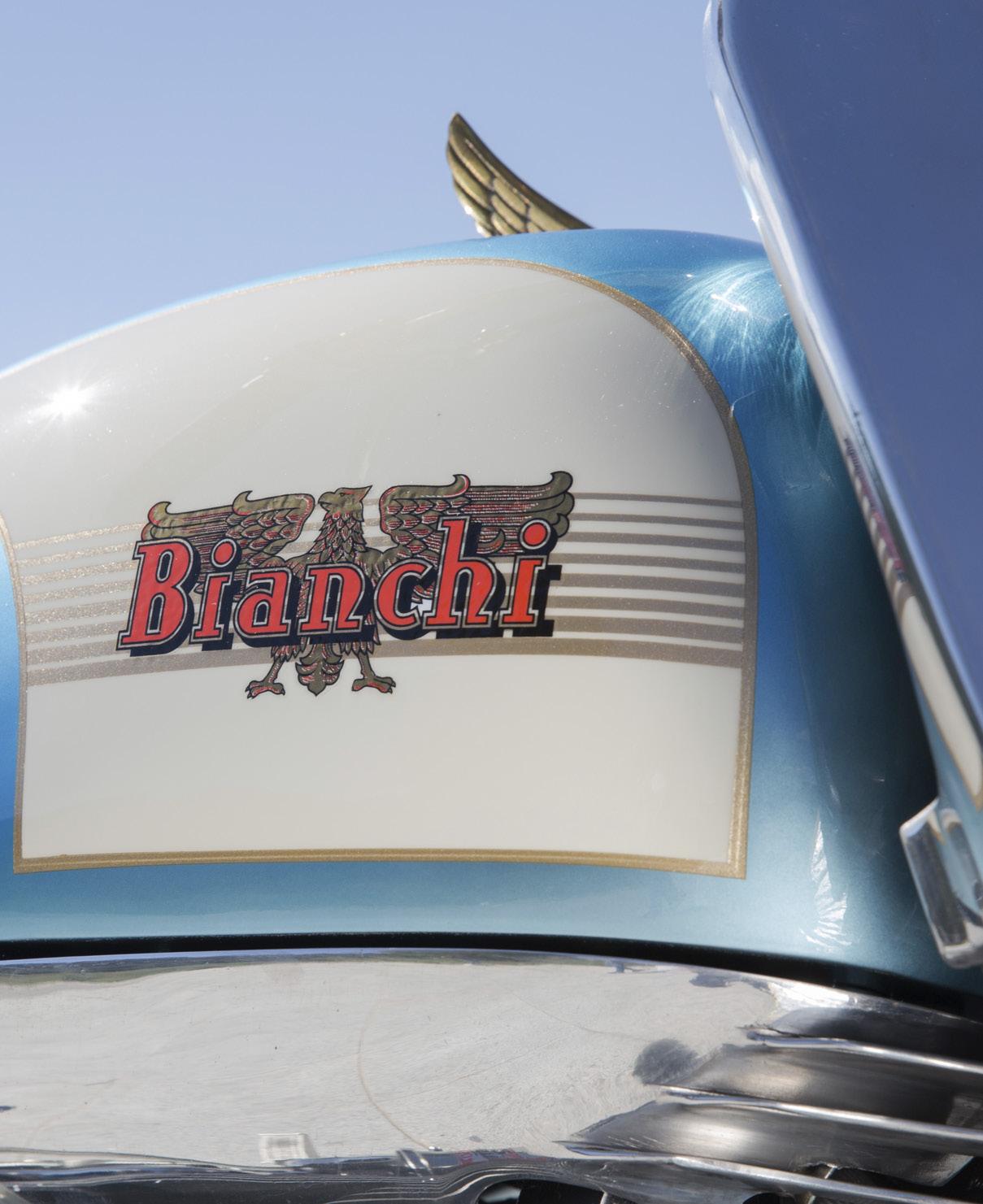


>
(opposite, clockwise from top left)
Mikuni flatslide was surprisingly easy to set up; Ink-based paint in ‘licked candy blue’ by locals, Fantasy Moto; kickstart reflects Bianchi’s 114 years of bicycle production.
(below) Winged filler cap once topped a 1940 Ford radiator
PLAN B FLYING ’57
Engine Rotax 560 from a 1990 Aprilia Pegaso, Bianchi bicycle pedal kickstart, Mikuni TMR 41 carb with accelerator pump
Frame Modified 1957 Bianchi Tonale 175cc
Forks 45mm Marzocchi Magnum with black DLC coating, polished and shortened
Rear suspension Kawasaki GPZ550 Unitrack swingarm, mounted upsidedown. Buell Cyclone monoshock
Wheels & tyres Front: modified Morini 350 drum-brake hub. Rear: modified SWM drum-brake hub, both hubs laced to 3.5 x 18in alloy rims. Dunlop K180 130/80-18 tyres front and rear
Fuel tank Modified 1954 Bianchi Cervino 175cc
Bars Universal wide handlebar in polished aluminium

Controls Harley-Davidson Knucklehead clutch and brake levers, Anderson footpegs
Paint Fantasy Moto, Laveno-Mombello
>
Christian credits that MSD coil with the bike’s smooth running. ‘A spark so strong it would probably burn coal’


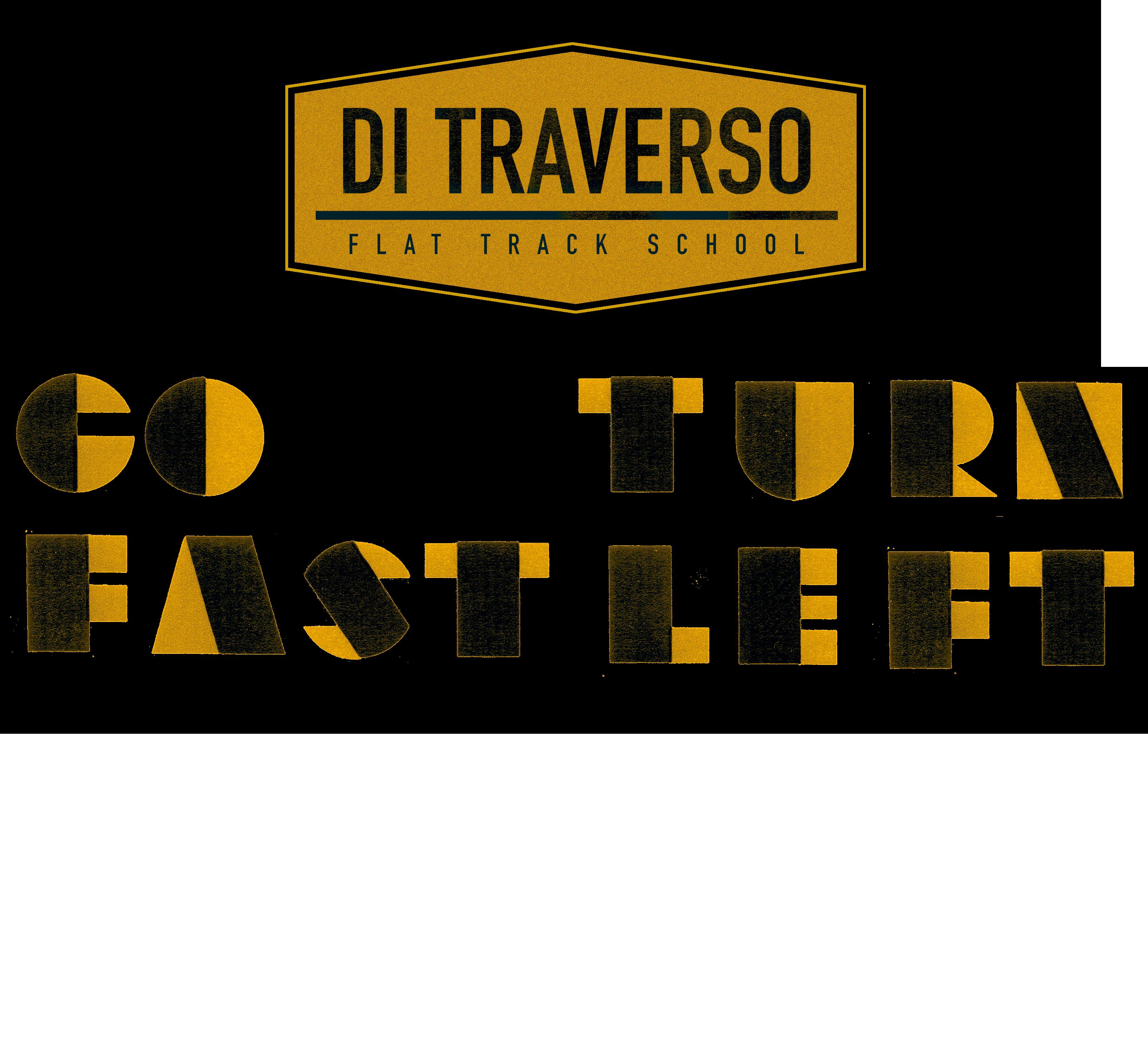

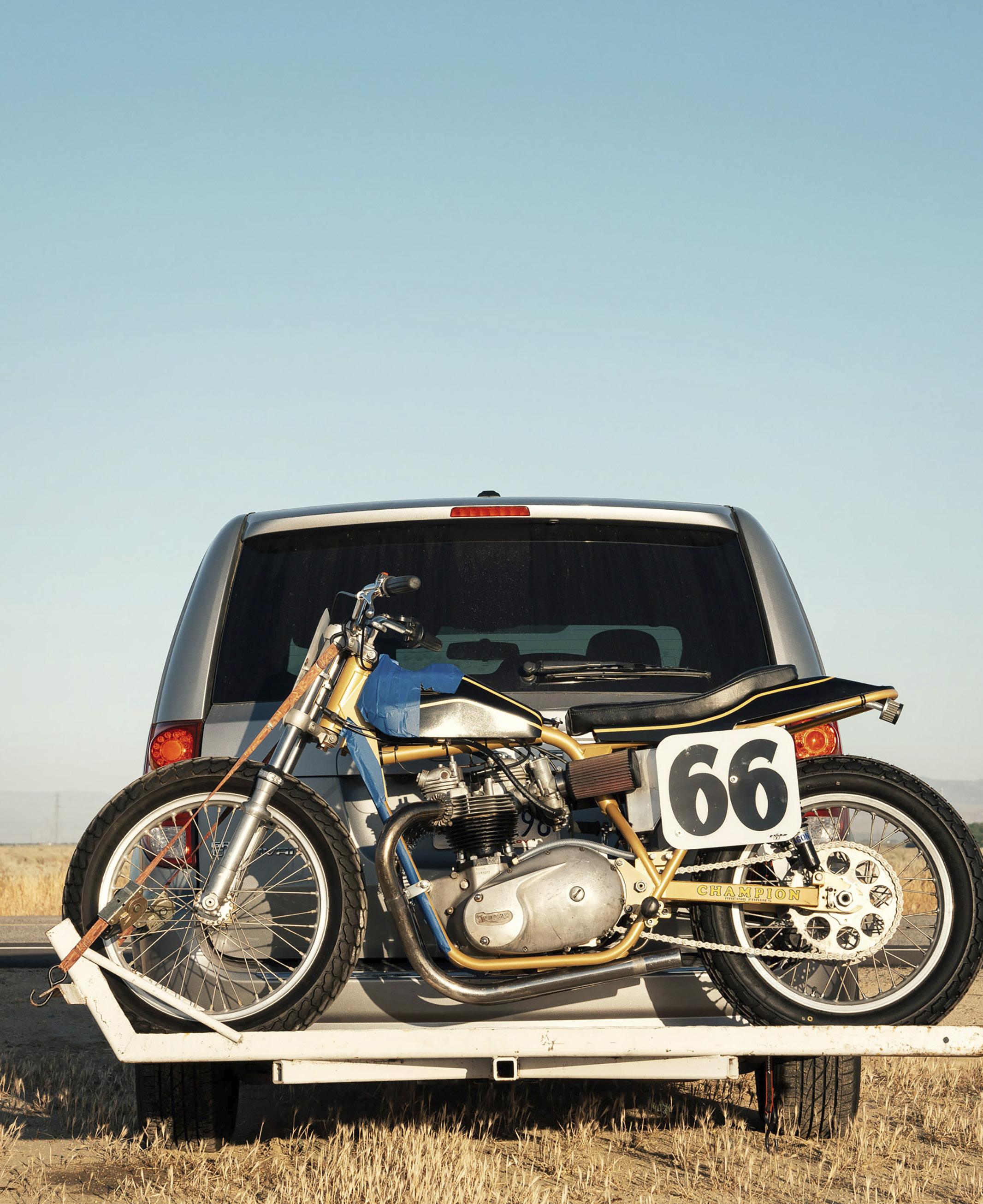
69 >
Words & photos: Scott Toepfer
A story of love lost and regained. And of hay bales
IN DECEMBER 2014 I had just enough ‘fun money’ to purchase this 1967 Triumph Bonneville from Hayden Roberts [SB34’s cover star, photographed by Scott]. Other than watching me flip, crash and otherwise break a couple of Harley-Davidsons, Hayden and I hadn’t spent a ton of time together, but, as I look back on that morning, it was really the early days of our friendship and the first of many projects we would chase together.
I’d never owned an old English twin before, but I wanted one. Anyone who has ever ridden behind one knows that they just sound and smell so distinct. This particular bike came with a rare ARD belt-driven magneto, a Bates scrambles seat and a Jack Hateley Enterprises sticker on the aluminium wedge oil tank. I was sold. My only experiences flat tracking were in the Hooligan class at Ventura Raceway, which at that time meant you rode your bike to the track, taped the lights up, took a quick swig of tequila in the pits with Papa Joe, raced, and then rode the bike home. I’d been riding a BSA 441 Victor for a couple years, so needless to say this monster was a big step up.
Over the next couple of years I probably hit the hay bales more than anyone should admit. I also battered the tank with my body in a high-side crash that still keeps my wife away from the track. The bike had become ‘mine’ in an intrinsic way that no other of my bikes really had before. But thankfully, I also got to race a Kansas half-mile, the Del Mar short track and got my first class wins at Ventura. I’d changed nothing but the oil. That damned ARD magneto would start the bike no matter how old the gas was.

The problems began shortly thereafter. Having lost miserably to Terry Vestal [featured in SB37] in Kansas, I’d been hunting for an elusive HarleyDavidson KR750. You see, I’d already had a mild obsession with 45in flathead racers, and this seemed like a tipping point for finding a track bike. I started piecing one together from a street motor,

‘OVER THE NEXT COUPLE OF YEARS I PROBABLY
HIT THE
HAY BALES MORE THAN ANYONE SHOULD ADMIT’
(clockwise from the top left) Scott recommends everyone takes time to race Kansas half-miles; An earlier version of this chassis with a Wassell trials tank and rough leather seat; It took a few years, but Scott finally figured out how to hold onto a good start; Racing brakeless in Ventura ‘Don’t get greedy on the low line without brakes.’
and in that process sold the Triumph racer to a longtime friend and fellow Triumph enthusiast, Nate Hudson of BA Moto, Long Beach. I’ve never been one to hold onto a bike too long out of sentimentality, so I felt like it was time to move on to bigger and faster machines. I traded in my jean jacket for a set of orange and black leathers and took the plunge.
After finishing the Harley and putting it on the track, I realised I’d made a terrible miscalculation. There’s nothing like being flat-out on the Sacramento Mile and needing 30 more ponies and 75 less pounds. My KR ‘replica’ would never hold up to the real thing on the racetrack, where my trusty Triumph, now leaning up against the wall at Nate’s shop, would’ve at least been competitive. I immediately went back to Nate and did what any crazy person would do: I begged to buy my bike back. I was relentless to a shameful degree, but after a couple of months I was able to retrieve the Triumph and bring it back home.

Upon its return, the bike took on the number 66 and, thanks to Greg Tomlinson, the nickname ‘Satan’s Little Buddy’. It was still fast on the starts and I continued to get too close to the hay. Now the real work had to begin. See, I’d never really learned to corner. At my level (novice) holding flat out on a banked half-mile just required a competitive nature, while the local races required a good start (thankfully provided by the handy ARD) and proper avoidance of the puddle that accumulates in turn 4 when the sun goes down. That’s the beauty of flat track racing. You don’t necessarily have to be the best rider on the best bike to win on any given night. Get a good start, be patient waiting for the rider ahead to make a mistake, and don’t blow the pass when you go for it. I love this sport for that earnest truth. But now I knew I’d need to start making incremental changes to help cornering.
I’d always been told that Triumph 650cc framers were rare compared to the lighter 500cc machines. I loved seeing the occasional Trackmaster at big events, so I started looking for a chassis. I hit up the local forums and came up empty until I got a message on Facebook saying ‘no can do on a Trackmaster, but I have a Champion you can buy’. I was elated, but still sceptical. The lore surrounding 650/750cc Triumph Champion frames states that only a dozen or so were ever made, and the records went down in a fire. So, if I was actually able to find

>
Scott admits ‘While this is likely the nicest photo of the prettiest bike I’ve owned, I’ll never be finished fiddling with it’

one, it would likely be a copy. But, always being a sucker for something shiny, I took the seller’s word for it, paid for it without seeing it in person, and asked a third party to put it in a pickup truck and drive it to California from Michigan.
Of course, the truck arrived in the middle of the night after being in transit for nearly a month. The rolling chassis was surrounded by lawn furniture in the back of the truck, and the poor fella had definitely been driving all day. Once you’ve done those long hauls, you recognise when somebody is fried from the road. I pushed the chassis into the garage, attempted to give it a once over under the light, and paid the driver.
I pushed that roller around the garage for months. Being the middle of the racing season with a busy work schedule and a family, I wasn’t cracking into this project in any hurry.

And then BOOM, Ventura Raceway cancels the rest of the local season due to funding shortages. It was prime time to get the chassis swap going. Also, the bike had just started puffing a little smoke, which was well earned after four race seasons without ever inspecting the top end. So, I hit up Hayden about a top end, and we had ourselves an off-season project.
As you see it now, it’s nearly finished. I know gold is a little gaudy, but this way I can still see the perfection of the frame welds, and it avoids the tedious frustration of getting a frame nickel-plated in California. Hayden built it with 11:1 pistons, a batteryless electronic ignition and Kibble-White valves, requiring $17/ gallon VP Vintage leaded race fuel. The tyranny of the whole thing is that after all the kind words describing my original ignition system, the frame rejected my prized ARD magneto. It’s now sadly in a box awaiting further instruction.
I say nearly finished because I’m never finished with anything. I’m changing the footpeg positioning, changing the rear brake system and sourcing a larger 650/750 Champion-style gas tank. The list will shrink and grow as I continue to brush hay bales and chase after local veterans of the sport, but damn, this is probably the nicest looking thing I’ve ever owned. Ventura Raceway is still closed for the local motorcycle season, but after debuting it at Willow Springs, I’m ready to try and match my skill to the bike.
>

‘Paint scheme is from a CanAm short tracker,’ says Scott.
‘The spring heatshield is an idea borrowed from my friend Julian Heppekausen’s Triumph 500’
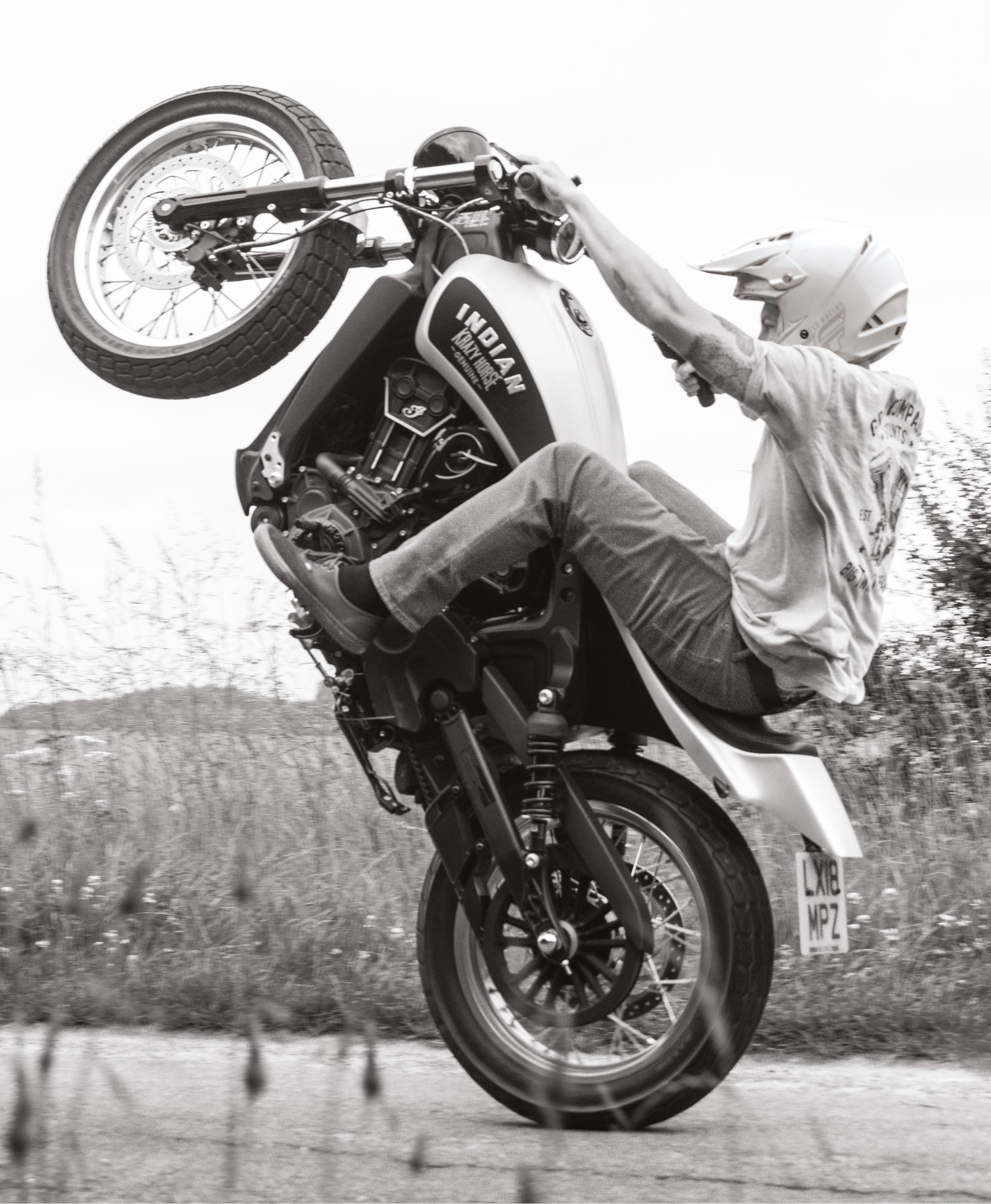


Epiphany
John Harrison rides a bike that makes him wet-eyed with emotion
 Words: John Harrison Photos: Stefan Marjoram
Words: John Harrison Photos: Stefan Marjoram
77
>
IT WAS THE pipes that did it for me initially. A pair of black high-levels like an early XR750, and perfectly proportioned to the bike. That and the front carb at an unlikely angle. My attention had been grabbed, but then I found another pair of those lovely exhausts on the other side. What? The penny dropped and I found myself on my knees oblivious to everything else for a good ten minutes while I tried to take in the detail, the build, the beauty.
Months previously, my son had returned from a working visit to our friend Duncan’s and told me, with no little enthusiasm, about one of the bikes there. JD bottom end, Peashooter heads, something special. He gave me a potted history of 1920s Harley single cylinder racers and where the bike fitted in to that story (I love it when my children teach me things, especially stuff from my world). He even showed me a picture on his phone, but I evidently didn’t look very closely, or perhaps snaps just cannot capture the essence, the spirit of a machine. Anyway, I didn’t think any more about it. I’d even visited the workshop myself and not noticed the dusty old racer squeezed in among the stack of unique and wonderful cars and bikes.
This time though, I wasn’t in a rush, there was a bit of space around the bike and when that penny dropped, it hit me on the head and knocked me out. The proportions, the condition, the style, the colours... it all seemed perfectly balanced. The engine is the biggest piece of motorcycle jigsaw art and this one is beautiful. I was familiar with and hugely impressed by Harley JD motors (inlet-overexhaust, 1200cc, massive torque). There are a pair in Duncan’s Shelsley Special car ‘The Hornet’ that my son races occasionally, so to top one of those with fabled Peashooter heads and make the induction and exhaust systems look so good was the work of an artist as much as an engineer. It was truly an epiphanic
(right) Four pipes are a clue to a pair of 1920s twin-port racing heads made to work on a twin. The Peashooter nickname reportedly comes from the unusual exhaust noise (opposite) Beautifully purposeful and fit as a butcher’s dog. A dog with exposed pushrods and rocker gear and a pair of Amal TT carbs


moment for me as I realised this was the finest pre-war motorcycle I had ever seen.
When I arose from my daze, Duncan told me the story of it. Built in the ’80s by the German speedway engine builder Harry Hacker, it was the first of a couple of 1920s Harley-Davidsons he put together. Harry was a racer and he campaigned the bike for a few years, which was when Duncan first encountered it, at one of those fabulous, long, mountain hill climbs favoured on the Continent.
Harry based it on a period racer built by the H-D factory in 1928 for a German called Knauff, who was frustrated by the fragility of the four-valve Harleys he campaigned in European races. The racing department correctly reckoned that a J bottom end fitted with heads from their 500cc racing single (two-valve, exposed rockers, twin exhaust ports) would be both reliable and powerful and should stop Herr Knauff sending angry telegrams and start winning races. Sadly, that original bike has been lost.
Harry used narrow Peashooter tanks on a JD frame, what are thought to be genuine works heads on Weslake barrels, fitted a pair of Amal TTs, fabbed the lovely exhausts and his own tuning magic completed the build.
Duncan was as similarly smitten as me and begged Herr Hacker to contact him if he
‘It was truly an epiphanic moment. This was the finest pre-war motorcycle I had ever seen’


Originally built by German tuner Harry Hacker, now further refined by Duncan Pittaway

ever considered selling it. That time came in 2001 or so, but the stars weren’t aligned for our hero and it was out of reach. The Harley was sold and disappeared, but Duncan never forgot how it looked, sounded and accelerated.
Ten years passed and he saw it was entered in a Bonhams auction. This time his situation was different. Having just sold an old car, Duncan had funds; except that he had promised his wife that the money was all going into paying off their mortgage. He entered himself on the Harley at a German hill climb two weeks after the date of the sale, just in case.
Viewing the Harley pre-auction, it appeared as if the owner had not used it at all. It had been untouched in the intervening years. It seems it was bought, owned and sold as a work of art. Not wanting to let it get away again, Duncan spent the mortgage money on the bike. I hope his wife doesn’t find out by reading this.
After a couple of events, Duncan needed to do some work to it and make it his. First thing was to ditch some heavy and ugly engine plates that Harry had convinced himself it needed, then he removed the Weslake barrels as he found their shape offensive, big and incongruous. He had some copies of Harley originals made by a company that look after the racing Morgan fraternity with their mega, air-cooled JAPs. He took it apart, found that the engine was built like a watch, and put it all back together. Then he went back to the European hill climbs and obliterated the competition. German competitors who knew the bike called it ‘The Widowmaker’ and evidently had enormous respect for Harry, the bike and now Duncan for riding it. Over the years it had acquired a mythical status and a daunting reputation.
He also took it to some closed-road races at Schwanestadt in Austria, where, in a mixed grid of pre- and post-war machines, once again the Harley stormed away from everyone. That was a few years ago now.
The next project came along, Duncan’s life was too full and the Harley was sidelined.

Seduced by the machine, I told editor Gary that I had discovered a perfect feature bike for Sideburn and tried to arrange visits to talk exclusively about the Harley and set up a photo shoot. It didn’t happen. Then, in an effort to see the Harley run, I offered to transport it for Duncan to The Montlhéry Vintage Revival, the biggest and most prestigious event in France for pre-1940 vehicles, in the knowledge that he was driving
there to compete in one of his cars. I was going anyway with my vintage flat track racing buddy Rick, taking his 1904 Rover Forecar, there would be space in my van for a bike as well and it meant that Duncan could enter two classes. It was late, entries had closed and all classes were full except for the Board Track Racers, but Duncan knows the organisers...
The next thing I knew was a competitor’s pack dropped through the door and it turned out that Duncan had entered me to ride the thing. He’s never let anyone else ride it. Montlhéry: the 1.6-mile concrete oval with 33-degree banking, built in 1924 as France’s answer to Brooklands, Indy and Monza.
I’d never been to Montlhéry, though I’d wanted to for years, but when I excitedly told people about my good fortune all I heard were dire warnings about the bumps and the chicanes. It seemed the track has a reputation as fearsome as the bike’s. What a combination. As she waved me off, I’m sure my wife doubted she’d see me alive again, but I was thrilled –and fortified by Duncan’s faith in me.
The meeting is run every two years over a weekend, the format being classes of similar cars or bikes being let loose on the two-mile road course which incorporates one end of the banking, albeit with a couple of chicanes at the foot to slow everyone down. The exception is the board track class, which runs around the full oval without a requirement to go through the chicanes.
They’re described as demonstration runs rather than races, meaning that no competition licences are required, but obviously everyone goes as fast as they possibly can, and running at height up the banking equals kudos.
Saturday morning was a washout due to rain, then it brightened up and I watched the two bike classes circulating, wishing I was out there. The final class to run was Board Track Racer and I proudly but nervously pushed the Harley into pit lane along with 13 others, ranging in date from 1909 to 1929. When I kicked it up it was only running on the front cylinder, the rear plug had apparently oiled up as it had fuel aplenty. I had to trust that as I got going it would clear and run properly, and it certainly pulled well on one. Leaving pit lane mid-pack, I opened it up and was surprised to have overtaken everyone in front of me before I’d got round the first banking and on to the back straight! It was going well for a single and I didn’t see any other bikes until I started lapping them. It never got going on both cylinders, but I had a
>
blast, riding to half way up the banking and standing just out of the saddle over the worst of the bumps. I finished the session elated, feeling like a Son of Speed [see SB34] and Duncan was pleased, but as miffed as I was about it being on only half power.
On Sunday morning, after changing plugs and successfully running it up, I determined to join in with the road-racing classes. This time I rode into pit lane and sat there for what seemed like hours blipping the throttle and praying that it wouldn’t overheat or oil up another plug. It didn’t, and boy did it go. I’m no stranger to acceleration or speed, and folks you’ll just have to believe me, THIS IS A VERY FAST AND POWERFUL MOTORCYCLE.
I realise these things are relative and of course we all know someone with a turbo-nutter-bastard on nitrous that is twice as fast, but we’re dealing with a 92-year-old bike here, rigid rear and an inch of barely controlled fork travel, not some blown and injected piece of modern tech. It reeled in everything on track then blasted away from them at warp factor fab, powering up to the top of the banking and staying well above the halfway line, skipping across the bumps, revs rising as the wheels lost contact, before diving down, tipping into the chicanes and firing skywards back up the banking again. It was utterly intoxicating and addictive; I was overtaking other bikes at twice their speed when I was shut off and braking for bends while they were still accelerating towards them. Actually, braking is also a relative term, the rear being the original contracting band and the front a slightly later drum that is definitely vintage. Fortunately, the high compression meant it lost speed effectively under engine braking. It was invincible on track, nothing else came close. Never have I felt so Ogri rather than Malcolm 1
(above) ‘It’s running on two!’ Having creamed the rest in an earlier session with an oiled plug, John prepares to do the same again, only faster
(opposite)
If you’re not up the banking at Montlhéry, you’re just not trying hard enough. And John is a long way up
I went out again for another race bike session and it was the same incredible, formidable experience of terrific acceleration, torque, excitement, joy and satisfaction. I got more and more confident as I got to know the bike, even scraping a footrest through one of the chicanes. With 40 or so other bikes on track I was constantly overtaking other machines, including pre-1940 GP bikes, as if I was aboard a modern superbike. Now I have a new addiction to go with vintage flat track racing that already holds me prisoner.
Then the clutch linkage broke. The gear linkage has a quadrant that prevents changes being made without the clutch being engaged, meaning I couldn’t slip it in and out of gear by using the throttle, so I reasoned I would try to get around a lap –which included a couple of hairpins and one very tight chicane –and if it chuntered and stalled in a slow section, too bad.
That remarkable motor got me easily around another three laps in top, pulling from no more than 20mph out of the tight bends. Then the session ended and with it my time in a perfect world.
Regrettably, without access to a welder, it was game over, so Duncan never got his go around the oval with the board trackers, but he was genuinely delighted to see and hear the Harley working and playing hard.

Now, we have no way of knowing if a version Harley made nearly a century ago was as powerful, or whether Harry Hacker is a tuning genius, but either way this whole motorcycle is a complete wonder, both dynamically and visually.
This story began by me being seduced by the look and aura of the bike, it finishes with me falling headlong in love with the way it rides. It has changed me. It’s likely that I’m only the third person ever to ride this extraordinary Harley and I don’t intend to dispel any myths about it.
Appendix 1 Characters from the cartoon Ogri, written and drawn by Paul Sample which was a regular for decades in UK magazine Bike. Further reference material: SB20 Peashooters and dirt track racing; SB14 p20 4v H-D racers; SB7 Homer Knapp and racing JDs.

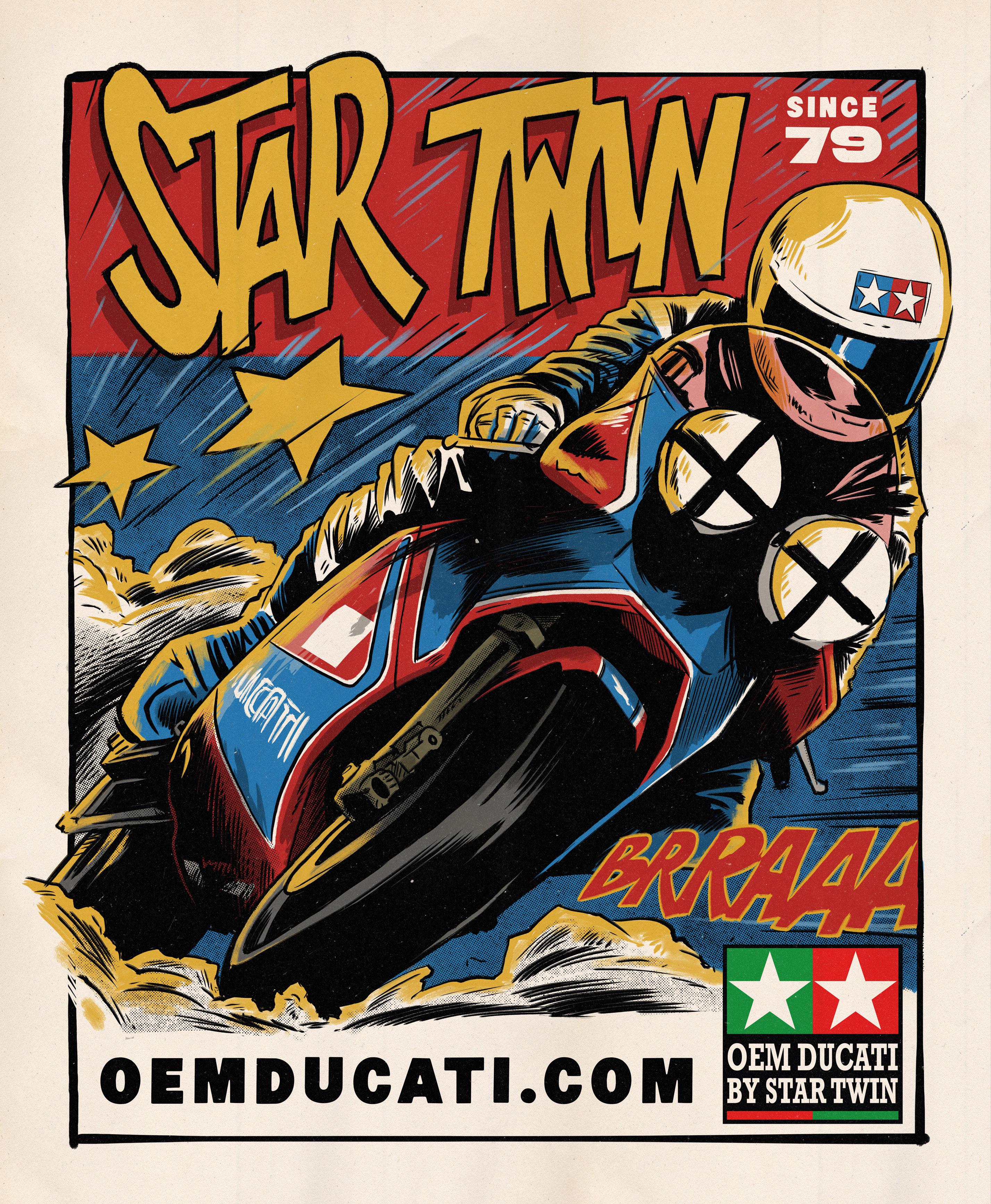
DIRT TRACK DANDY

85 >
LONG
BEFORE GRAM Parsons’ Nudie suit became an iconic fashion calling card for a nation of stoners, it was cowboys and country stars alike who lined up for tailor Nudie Cohn to bring fresh flash to their stage wear. From Roy Rogers to Porter Wagoner, Cohn’s signature thumbprint in the world of costume art made its mark on the world. Did it make the music better? Obviously not. But the act of a showman is never lost.

The stage of flat track racing is host to a dance as much as a sport. No matter how much money, time and others’ expertise is bestowed upon you, it never guarantees a victory due to the intimate timing between multiple riders stuffed onto a small oval. For the past five years or so, I’ve been consciously working towards looking like I know what I’m doing on such a track. Elbow up coming out of the turns, keeping your butt shifted coming out of turn two, tapping the brake at the apex… all while navigating between five to seven other guys around me who may or may not be thinking the same things.
With all those variables adding up, I have to tell myself to have fun no matter the gains or the losses the long day will bring. Whether the trophy is a nod from a fellow rider or the stories you share with your mates, I try to really enjoy myself in the nostalgia of racing vintage motorcycles. If you are going to race vintage, by God, live it.
So, when I nabbed a cheeky set of baby blue Bates leathers off eBay a while back, I was already propelling myself into standing out within our close-knit race community here in Arizona. Ironically, I’m the only one, besides my dear friend and fellow racer Joe Cude, who is running full leathers in the summer series here, as temperatures routinely pass 110 degrees during race season. Where most would opt out of such things, the cocky city-boy and internal dandy that I am can’t help but push it a hair further. With inspiration from Don Castro’s psychedelically glassed Triumph 750 racer to Aldana’s skeleton leathers, I sought out artist Laurén Bienvenue out of Jersey City to finalise my nostalgic costume dreams.
The result is Nudie Cohn-inspired head-to-toe leathers with all the accoutrements of Arizona and desert-living icons you would expect; cactus to sting my opponents, bucking bulls for the rut in turn three, booze bottles for the pits and a rattlesnake to remind you of your last mistake. I may not nab a first place against our fastest guy in the vintage 600cc class this season, but that’s not really what it’s about, now is it?
@themotoattic
Vintage Bates Suit hand painted by Laurén Bienvenue @onceuponalauren
Words: Matt Welsh Photos: Scott Toepfer
Handpainted leathers + Ruby Castel + original Ken Maely flat track boots = Dirt Track Dandy

>
The Moto Attic
TT500

Yamaha
l De-raked SR500
frame;
540cc
engine tuned by
Barracuda
Racing
l Betor
forks with
Barracuda
Racing triples
l Knight
swingarm by
Barracuda
Racing
l
Öhlins shocks

Dirt

Pervert
Still only 27, George Pickering has created Europe’s favourite dirt track and runs a six-rider amateur flat track team. Er… how?
Words & photos: Dave Bevan
GREENFIELD DIRT TRACK is the best flat track in the UK, probably Europe, maybe even beyond. I heard it said time and time again, by a non-partisan group of not necessarily so-likeminded individuals at a recent DTRA race meet at Greenfield’s hallowed turf.
When bold claims start being bandied about, it’s time to sit up and pay attention. When bold claims start being bandied about and the main protagonist is a 27-year-old farmer with no backing other than a bit of space, some inherited farm equipment, a patient and loving family and enough drive/weirdness to make something amazing happen out of literally nothing but mud and dust, then it’s time to get down in the dirt and find out more.
Driving to the track, in middle-of-nowhere Lincolnshire, six miles inland from England’s bleak east coast, I was being battered by several liquid inches of falling winter weather, totally befitting England in June. It was hard not to envisage a total washout of a mud-fest in waiting. Arriving at the farm-come-racetrack, I find George, Matthew, Toby and the rest of the Greenfield crew hiding away, downing bottles of Bud in the bright green portacabin that serves as both Greenfield HQ and something of an inner sanctum. Hiding not only from the falling rain, but also from the gathering crowds of expectant racers, mechanics, spectators.
‘I’m hiding away in here, drinking with my mates, because everyone out there wants to know, and probably has an opinion on, what I should be doing about the weather, well, about the track at least,’ George deadpans over his fourth or fifth bottle of the afternoon. ‘Well, for now, the answer’s fuck-all. We wait. It’s easier and more fun to sit in here drinking with my mates than say that a hundred times a minute out there.’
The mood is jovial and restless. There’s no moping or idleness to this particular fuck-alling. Everyone is constantly glancing skywards while simultaneously checking, updating and rechecking the weather apps on their phones and, in turn, bickering and bitching over the ever-conflicting information therein. Olde world farm lore is butting heads with late-stage capitalist technologies, and no one’s really any the wiser for it, but the vibe and the craic is solid, nonetheless.
There’s definitely a tension though; George cares, really cares, not so much about the weather, but the wider impact it’s having on his track, his mates, extended family and this event, one that has brought several hundred people from various points around the globe to his own private Idaho. For all his outwardly relaxed, quiet confidence, you can see George is uneasy with just waiting. He’s a man of action; you don’t end up responsible for your own national-quality flat track any other way.
‘Greenfield’
George farms all day, track preps most nights, rides when he can
Looking out at the water gathering in puddles, which are increasingly becoming small lakes sat on the shiny surface of the track, George muses, ‘In the three-plus years we’ve been doing this properly, I thought I’d seen most of the possible weather conditions, but today’s a new one, because it’s rained all day and I’ve done nowt, which is why I’ve been sulking a bit in here. Normally, I’d be out there in the
> 91
Motocross Track
Practice track that is ideal for minibikes, but big bikes tackle it too Spot the Pick-up Brits prefer panel vans to trucks
 Aerial photo: Tom Bing
Aerial photo: Tom Bing
The Jump
DTRA TT races run without front brakes so the entry to the jump is relatively slow Minibike Oval

Used for CRF100 death matches and training for novices
The Groove
A fast 305m (0.2 mile), blue groove, clay short track
TT Loop
Riders turn left where the flag marshal is stood
>
tractor, ripping up the wet surface and spreading it out so that it’d dry out faster, and then repack it with the truck. But today I’ve not done that, which is against my character, because I’d almost always rather have a go, and if I fuck it up, then so be it, at least I’ve had a go. But we’ve got tomorrow’s racing to think about too, so you’ve got to be a bit cleverer. You can’t rush perfection. I’m learning... Trying to at least.’
The never-ending quest for perfection is clearly central to George’s dreams and schemes for Greenfield.
The well-ridden path of growing up in the countryside, with the wide-open spaces suited to getting into riding motorcycles as a kid, before then finding your way into motorcycle racing, is a well-told tale. But it’s a bit of a leap to go from hooning around your dad’s wheat fields on a moped to building and running a flat track, one that doesn’t necessarily follow any common logic.
‘My grandparents weren’t really motorbike people, they were more into horses, proper old-school country folk. By the time I was a teenager I’d got the flat track bug bad, so I half ignored them and marked out this tiny little track in a fresh wheat field that I’d only just planted up, just to have somewhere to tear about on. I never did any work to it other than mark it out and then raise some dust. By that point I was well and truly hooked, and also got my folks sort of onside, so built a slightly bigger track and started to learn how to prep it; watering the track if it’s too dry, grading it, adding to and taking away from the surface as required. I built a tyre-packer 1 to try and get some compression into the surface.’
George recalls the track’s formative days. ‘When I travelled to different speedway tracks in the UK, I compulsively quizzed the groundspeople about their methods and equipment, taking photos and becoming completely obsessed with the science and mechanics of it all. I still visit speedway tracks, even though it’s a completely different surface to my flat track, and grill the guys to death! When I go to Spain to race, I find someone who can speak English and drag them along to the tracks with me and get them to translate while I barrage the Spanish track guys with questions. I’m always trying to learn. It goes hand in hand with farming... I just like dirt. We farm the dirt and it needs to be in the best condition to grow the best crops, and likewise, the dirt on the track needs to be in the best condition to make the best track.’
The passion George has for making his track the absolute best it can be quickly becomes apparent in conversation, but it clearly goes deeper than just a passion for science, agriculture or indeed motorbikes.
‘These days, I go to tracks all over Europe and I take samples of dirt off the track, stashing it in a water bottle or a rubber glove or whatever I’ve got to hand.
Appendix
I look like a weirdo! I put it in me mouth and taste it!
There’s salt in this mud from Superprestigio. Why’s that, then? What’s that salt doing here? And I’ll bring it back to my fertilizer guy over here and get him to test it and tell me what it’s made up of. I’m sure he thinks I’m a weirdo too. It never ends, I’m always on the lookout for what’s going on underfoot. I guess that’s why Anthony [Brown, of the DTRA] calls me the Dirt Pervert.
‘We started making this current version of the track back in October 2015. I’d spent weeks on Google Maps looking at and measuring the aerial views of 15 speedway tracks and working out the average lengths and widths, and then me and my mates set about it here. It was a disaster actually. October out here can be very much dead winter, and very quickly, what we’d dug was completely under water. It looked that bad I nearly cried. I thought I’d just made this huge mess, but we carried on and kept at it when we could, putting in better drainage and raising and improving the track. Spring came around and we got it in shape just in time to pull off our first DTRA meet in 2016.’
At this point, George’s ever-busy dad, Michael, wanders by with a brush in his hand.
‘There’s my dad, look, mopping or summat, he’s always doing summat, but more than that, he just lets me get on with it. If I had a lad my age, and he’d dug a big hole right in the middle of one of my fields, which then instantly filled with water and looked a mess, I’d have had his trousers down I reckon, whether he was 27 or not! I’ve got respect and rate my mum and dad for that.’
That Greenfield is a family affair is unmistakable. George, his parents, his girlfriend Leah [Tokelove, the Hooligan with Pigtails] and Matthew, Toby, Freddie and the other mates who help make Greenfield happen, are everywhere, all the time, constantly doing something to improve the track, and the craic, even if that’s doing nothing but having a laugh and lightening the mood. It’s so much more than just a track, even a really good one; it’s a living, breathing, bickering, loving community, existing around the common goals of motorcycle racing and fun.
For all that I don’t know racing, I do know a bit about farming, having lived and worked on a small arable farm in Vermont for several years in my early 20s, and I know it’s very much a fuller than full-time undertaking, that doesn’t leave much time for anything else at all, let alone something as labour, time and energy intensive as building and maintaining dirt tracks. I wondered how George balances the two.
‘Well, time-wise at least, it doesn’t really balance at all, but in terms of everything else, it totally does. The track wouldn’t be possible without the farm – its space, land and equipment. It just wouldn’t exist if I lived somewhere else. And that makes me
1 A large, rolling weight towed behind a tractor that compacts the surface of the track.
(clockwise from top left) ‘It’s wet, boy’, George and Matthew assess the conditions. Matthew is a Greenfield regular who sells tractors and farm equipment to Greenfield and surrounding farms; Patience pays off; In the Foden. Mood improves as tyre packing commences; From soaked to dusty in six hours. George knows how to prep his own cocktail of dirt



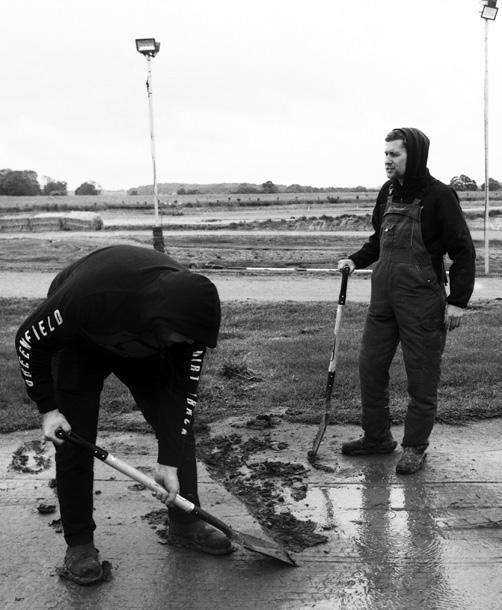
>
appreciate the farm and the farmwork all the more. It makes it easier to work hard during the week, while daydreaming about the track. And the track and the racing makes me excited about doing the farm as best as I can, to keep it all ticking over.
‘It can get pretty bleak and lonely out here in midwinter, when the track’s just a big, muddy mess and there’s no racing for months, but the thought of it coming around again, and the improvements and the learning, really do keep me going through the dark months. That’s pretty important, I think.’
The rain doesn’t let up throughout the whole of Saturday, making George’s patience in leaving the track alone, so as not to bugger it up for Sunday’s racing, look wiser than perhaps it did at the time. But Greenfield is no place for idleness, so as the rain turns into fine mist, clouds streaking the massive Lincolnshire skies above, the minibikes are fired up and an impromptu and chaotic bout of racing spills out all over the motocross track George has created around the trees off to the side of his house.
It is motorcycle racing in the loosest, daftest sense and the spills on bikes outweigh the beer spilt as spectators jump out of the way of wayward riders.

It is hilarious and just what an otherwise wash-out of a day was needing to lift the communal spirits. It confirms my growing notion that Greenfield is much more than just a racetrack.
The tales from the day get ever taller as the sun sets. A band starts belting out Creedence et al from the trailer of an articulated lorry, and the booze, laughter and shit-talking about tomorrow begin to flow in earnest. At some point I pass out in the boot of my car and dream of smuggling soil samples from foreign lands wrapped up in latex gloves secreted about my being. I may have been here too long.
Waking crumpled and internally foggy to bright blue Sunday skies, I stumble out of the boot and find George and Co already in full flight.
‘The track’s drying. We’re gonna pack it with the Foden. Get in!’ George calls, bustling past me and hoisting himself up into the truck he uses to compact the surface of the track ready for the day’s racing. I was just trying to put my brains back together if truth be told, and it turns out that up high in George’s cab is the best place for that job.
Riding shotgun in undulating laps of the TT track, I watch as George excitedly shoots the shit out of his wound-down window with the growing crowds of friends and racers watching the progress of the truck and gauging the state of the surface. He’s in his element. The track is holding up; the work the Greenfield lot have done in the early hours to address the worst bits of the sodden surface is compressing and drying and settling with each lorry orbit, and the spectacle of a beaming George looping his truck around the bends and up and over the TT jump is pure, unfiltered Greenfield magic.
‘It can be paradise out here...’ George says, between tooting the air horn and perhaps subconsciously, perhaps not, putting on a bit of a show for the expectant onlookers, rewarding their faith and patience carried over from yesterday’s heavy weather.
‘Sometimes, when it hasn’t rained for three months and I’m on the phone to Anthony, nearly crying, drunk and stressing, I think, I don’t need this track, this stress! But I do, I really do. It brings people together. It brings my friends together, my girlfriend Leah, my dad and all these people. There’s some Spanish blokes here, a lad from Japan and a couple from America. It’s community.’
With this statement, Greenfield suddenly makes perfect sense to me. I had been quietly wondering why George and crew pour so much energy and time and learning and everything else that they willingly give, day in, day out, to make the track and all surrounding it happen, when it could all be washed out with a day or two’s wet weather. A few laps of the track with George in his truck on a bright Sunday morning blows that slightly cynical question out of the everdepleting water.
‘This isn’t a living at all, not even close. It’s an after-hours farm thing, and it’s got a bit out of hand if I’m honest, but in a good way. I love riding and racing and all that, but the track, and all this, this bunch of young lads getting off their arses and doing something, and this community, is what’s really important to me. And here I am, driving my truck around the track, babbling to you first thing Sunday morning and it makes me want to start crying. Yeah, it’s got a bit out of hand, really.’
‘Sometimes I think, I don’t need this track, this stress!
But I do, I really do’
Team Greenfield
Greenfield isn’t only a track. With Team Greenfield, an amateur flat track squad nurturing talent from the top to the bottom of European flat track, George Pickering has taken on far more responsibility than just building up his race facility.

Supported by local and national companies, the team is currently seven strong and made up of DTRA Pro, Rookie and Youth riders. The majority are raised in Lincolnshire, living less than an hour from the track. The two that aren’t local are Gerard Bailo and Ferran Sastre, Spaniards who fly in to race in each round of the Dirt Track Riders Association championship. The youngest racer, and one of the youngest members of the DTRA, is nine-year-old Toby Johnson. This is his first full season racing and he’s on a team with UK champion Toby Hales, as well as Spanish champion, Bailo.

This is Team Greenfield’s second season. In the first, George (the man behind the magic) and Bailo, were the only Pro riders, coming second and fourth in the standings. I raced in the Youth Senior class, finishing third in my first season on a 250. Fergus Bluff was runner-up in the Youth Inter class team, while Johnson placed sixth in the Youth Junior class.
As I write this, the three Greenfield Pro riders are in the top four of the DTRA championship, with Bailo leading. Being on the same team as these top racers really helps the younger riders.
All of us race Kawasakis and get essential mechanical and riding advice from George and his right-hand man, Steve Nicholls. Both are very hands-on with the team on race day, doing everything we could possibly need, including watching our performances in practice and races and sharing tips to tell us as soon as we’re ready to listen. We would’ve struggled to achieve what we have without their help.
For 2019, George has paused his own racing in order to improve and focus more on the team and the new faces who have joined, Greenfield regulars Hales and Sastre. I have moved up into the Adult Inter class, Bluff has graduated into the Youth Senior class and Johnson remains in Youth Junior with Thomas Hunt in the 85 class. The team has not only helped us by improving our racing, George has also supplied our matching riding gear and graphics for our bikes, making us all look more professional, over seven bikes with matching graphics under the Team Greenfield gazebo.
Thanks Team Greenfield, I’m proud to be part of the team.
 Max Inman
(top to bottom) Spanish champ Bailo, eyes on the lights; Hales v Bailo; Max Inman
Photos courtesy of DTRA
Max Inman
(top to bottom) Spanish champ Bailo, eyes on the lights; Hales v Bailo; Max Inman
Photos courtesy of DTRA

BAILO
Team Greenfield’s 2019 DTRA Champion
Words: Leah Tokelove Photo: Tom Bing/DTRA
IT SEEMS 2019 is proving to be a year of firsts in dirt track circles. (Get it? Sorry.)
It’s the year that a rookie won the Singles class at the Peoria TT, Hooligans won medals at the X Games and a Spaniard clinched the Pro title in the Dirt Track Riders Association UK national series – with one race remaining.

That Spaniard is 24-year-old Gerard Bailo, a racing export from Tarragona, in the north-east of his home country. Having twice climbed the podium at Marquez’s Superprestigio and having graced Rossi’s Ranch, Bailo means business.
I’ve come to know Gerard quite well and one thing is for certain – he’s driven. Finishing as runner-up in 2018, his first full DTRA season, he was determined to complement his 2018 Spanish Championship victory with a UK title. Racking up the air miles, Gerard flies in and out of the UK for each meeting, with support in the UK from Team Greenfield Dirt Track, who work closely with Spanishbased Noyes Camp to develop high-calibre European dirt track talent. Gerard races a Greenfield Kawasaki 450, alongside Brit Toby Hales and fellow Spaniard, Ferran Sastre.
Bailo may be aggressive on the track, with a fierce riding style, but he’s well liked in the DTRA paddock. He explains that one of the reasons he loves racing in the UK so much is that we’re all so friendly. He believes the variation in the tracks and the high level of racing he’s experienced in the DTRA is fitting preparation to take his racing Stateside, where he hopes to compete in the future. He’s the third different DTRA Pro champion in as many years and we (and the budget airlines) hope he’ll be back to defend his number one plate in 2020.

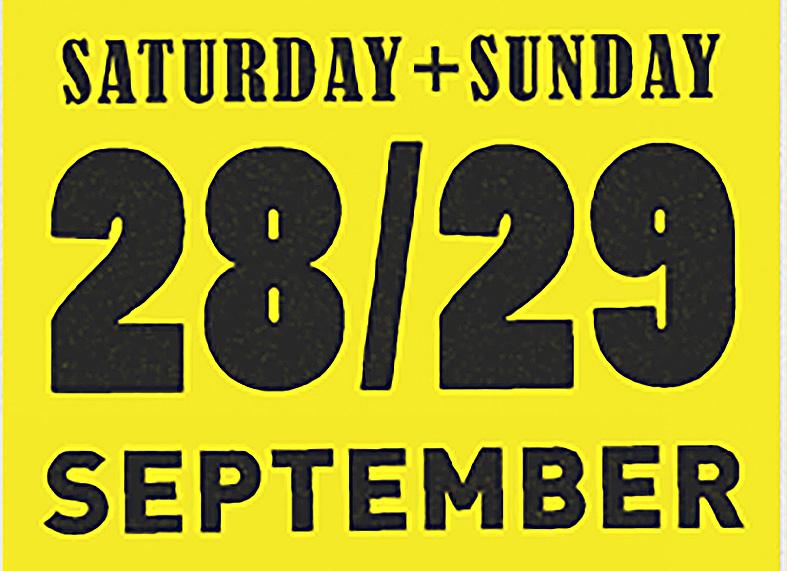







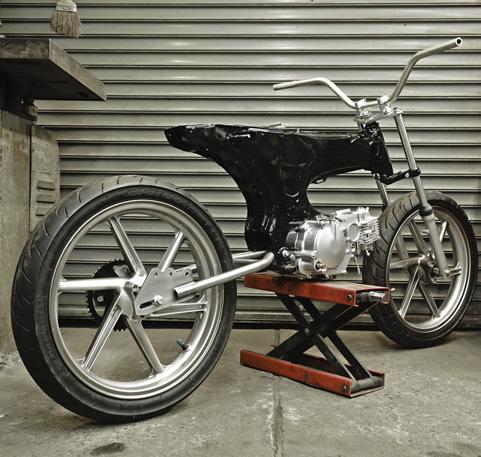
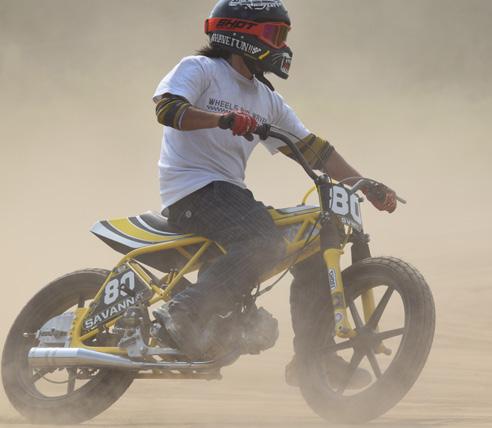


101 HAVE FUN !! Super Cub / DAX / Benly / Monkey って知ってる? 日本ではとてもなじみ深い横型小排気量エンジンを搭載した シティーバイク。 この低重心エンジンを使って日本の風土にあった面白い Mini FTR を作ろうと ライダーでもありバイクビルダーでもある仲間が集まって始め た HAVE FUN !! スタートしてはや1年、10台近くのフレームから製作したスペ シャルな Mini FTR は生まれた。 しかし、最大の弱点が、、、「High Price !! 」 Buddy CC が 製作した実験 中の Benly FTR CHEETAH が 製作中の Dax FTR CHEETAH がフレーム から製作した New Machine って事で少し原点回帰。 だったら Dax / Benly / Cub のフレームをそのまま使っち ゃって 日本では大半を占める Quarter mile 以下のレーストラック なら450に食らいついていける Mini FTRをただ今開発中。 450に噛みつく Cub / Dax / MonkEy なんていたら最高に COOL !! でしょ!! しかも Low Price でね。 そして今年の HAVE FUN !! は FANTIC JAPAN と 組んで CABALLERO FTR を 使って 面白いプロジェクトを進行中。 次号のこのページで HAVE FUN !!の今 後の動きを発表していくつもりなのでお 楽しみに。 そして最後にこの貴重な1ページを与え てくれたGaryに最大の感謝を! Words & photos: Toshiyuki ‘Cheetah’ Osawa



Simon
A purr is a tonal fluttering sound made by some species of cat. It varies in volume and tone among species and in the same animal. Although true purring is exclusive to cats, other animals produce purr-like vocalisation. Species that produce purr-
sounds include mongooses, raccoons, bears, badgers,
tapirs,
street-legal

through
lemurs, gorillas
guinea
Simon’s
Slingshot, cooling down after

103
like
foxes, hyaenas, rabbits, squirrels,
pigs,
ring-tailed
and
barely
’89
a sweet ride
the mountains. Words & illustration: @tattoo.lenny
A glimpse into the lives of Lennard Schuurmans’ tattoo flash characters
PROJECT BIKE

Gary’s favourite race ride finally gets its time in the Sideburn spotlight
SIDEBURN
HAS FEATURED
the bikes I race and their evolutions since SB25, only missing a couple of issues in that time, but I’ve just realised we’ve only described our 1991 Harley Sportster hooligan and Honda 650 sand racer, and never the bike I love the most, this Wood Rotax.
Jason, who has had more bikes featured in Sideburn than any other individual, imported the bike from the USA in 2007. He removed the upside-down front end, triple clamps and rear disc, to fit them to a Harley XR1000 he was modifying, and sold the rest to me. I can’t remember how much the asking price was, but it was very reasonable. I sold the Knight Rotax I was riding, bought some Yamaha R6 forks from eBay and imported triple clamps and a
floating rear disc and carrier from A&A in the USA.
The adjustable triple clamps arrived and looked great, but the holes for the forks were too small. I contacted A&A and was told that was impossible, because they didn’t make them in other sizes. I had the forks and triple clamps in my hands. Different sizes. The next race was coming up, I was nearly out of time, so I had a friend, Simon Martin, machine them and that was that.
Ten years later, super-fast Canadian amateur racer Don Galloway, whose Panther Honda XL350 was featured in SB27, wrote to me saying, ‘Do the Americans treat you Limeys the same? Ship a part that has a defect and know you will never ship it back due to the cost? “American Trick Shit” we
call it. Never bolts right on without modification and they deny any wrongdoing until you drive or fly the 2500km to sit across from them and then all of a sudden the issue gets resolved.’ As a matter of fact… But that is the only slight downer I’ve had with this bike and that was nothing to do with Wood Racing or Jason. Since then, I’ve started (and finished) well over 500 races on this bike. It’s closer to 600 now. The bottom end has never been apart in that time. It’s a 600, and I have a feeling I put some new rings in it six or seven years ago, but maybe I didn’t. Carl at CFM gave the valve seats some attention. More recently, I replaced a broken inlet rocker arm. It’s had the same clutch for at least ten years. The number one most useful modification is a

Words: Gary Inman Photos: Gary
Inman, Adrian Mortimer,
DTRA
CONTACTS AND THANKS
Bars bandcexpress.co.uk
Engine rebuild cfmofsleaford.co.uk
Exhaust racefituk.com
Flat track parts co-built.net

Fork covers survivorcustoms.com

Paint deathspraycustom.com
Race series dirttrackriders.co.uk


Rotax spares sportaxracing.co.uk
Tank redmaxspeedshop.com
Wheels performancemachine.com
This story
Co-Built remote starter socket on the end of the crank. After eight years of stressful bumpstarting in increasingly busy pits I’d had enough. Fellow racer Brad Hardman modified a Chevy small-block starter motor and I made the plate and handles for the remote starter. I’ve had the frame powder-coated twice, but the swingarm has its original nickel plate. It’s looking a bit tired. Until the first race of 2019 I’d had the same WP piggyback shocks in all that time too. The current shocks are secondhand Fox units I bought from SB contributor Scott Toepfer. They’re slightly longer, and I’m using them so I can get the swingarm angle closer to the -5 degrees from horizontal that I’ve been recommended is ideal.
It has the original seat unit it came
with, but I wore out the pad and had it reupholstered. I also bought a new fibreglass tank from Red Max, when the first lost its rigidity due to having fuel left in it. I now drain it dry on the night of the race. The bodywork has one of a kind Death Spray Custom paintwork. I’ve had eight or more different sets of bars. They’re currently Renthal 613s. A replica disc, made for the knock-off centre, replaces the one bent in a crash at the final race of 2018.
The other major changes are the pipe and wheels. I replaced the spoked rims for Performance Machine Dirt Track alloy wheels (also bought from Jason). They were polished, but I recently had them anodised. I’m not sure how the coating will fare on the abrasive UK flat tracks, though. The quick-
change disc and sprocket are held on with Co-Built locking rings. The Racefit Ti pipe was also from Jason, who had it made for a C&J Rotax he had for a while. My Racefit pipe was damaged in the crash that wrecked the rear disc, but I’ll have it repaired at the end of 2019.
So, why have I stuck with this bike for 12 years now? A bunch of reasons. I prefer riding bikes to repairing them, and while a Trackmaster Triumph twin is the archetypal classic flat tracker in my opinion, and they do come up for sale in the UK, the Rotax engine is close to bombproof in a way few vintage bikes seem to be. Plus, unlike a DTX bike, I can race this Wood in two DTRA classes (Inters/ Pros and Thunderbike), so I get twice the action from one bike.
Also, the Wood Rotax has plenty of family heritage. Bikes very similar to mine have been used by Chris Carr to win the Peoria TT. As I write this, on Monday 6 May 2019, Jeffrey Carver has just won the big money Eddie Mulder Willow Springs race on a monoshock version of this very bike. On the 3/8th-mile track, he beat Jared Mees, who was riding his factory Indian FTR750, and Sammy Halbert on a championship-winning Dodge Brothers Harley XR750. But, no one is currently building these frames. Still, Wood Rotaxes rule.
And, by the way, it’s always Wood Rotax, not Woods Rotax. Thanks.
105
was supposed to go in the previous issue, but we ran out of room. Since writing it and sending to the printers Ron Wood passed away. He was 90 and still working on bikes. Thanks Ron
Bonnie hooligan
Paul Hartman’s Triumph is our new favourite heavyweight
I was racing a Harley Sportster hooligan until I smashed it up. When I came to build a replacement I thought about all the options. We really don’t need a ton of power in hooligan racing, it’s more about traction and getting the bike to handle well, so I decided on Triumph and bought a bare Bonneville frame online. The engine itself is pretty stock with K&N high-flow filters and a custom-made exhaust with an S&S end can. I’m happy with how it worked out. These are the rest of the details...
Electrics
I have it set up as a total loss system, removing some internal parts to keep weight down. My battery is 9oz (250g)
Shocks
I tried a few different options and ended up getting the best results with 14.5in Öhlins 963s
Brake
The caliper is a Brembo 32. The hanger and rotor were made by a fellow racer, Nick Henderson. The brake pedal and some other components are stolen off an FTR750
Bodywork
This modern XR750 tank is one of my alltime favourites, it’s from Gopher Glass. The Airtech DTR1 tail has a pad I made and covered with MX gripper material. The riveted panels protect under-seat electrics
 Words:
Paul Hartman
Photo: Lane Kloskowski
Words:
Paul Hartman
Photo: Lane Kloskowski
Controls
Front end
Oil cooler
Wheels

ProTaper EVO Dirt Track bars; Works Connection Elite lever; Motion Pro Rev2 throttle and cables. Bates footrest on the left, MX gripper on the right. The footrest brackets are custom and connected to the original Triumph mounts
Performance Machine DTs with Dunlop rubber
I used Weiss adjustable trees and R6 forks. The best combo in my opinion. The dash is a rad AIM Solo 2 GPS lap timer. They claim accuracy within 1/50 of a second
It’s one of Mule’s kits and works really well. Mule supplied the carbs and some other bits, he’s a good guy 107 Turn over to see Paul’s hooligan race kit
Racewear
Trusted: Art director Paul Hartman moved to California from Minnesota for work and threw himself into the local flat track scene. These are his day-at-the-track essentials

1 Man Wolfs cut
Sometimes you have to keep things weird at the track. I first wore this selfmade cut at a Hell On Wheels hill climb. It stays in the van. If you don’t know who the Man Wolfs are, do yourself a favour and look up some videos.
2 NJK leathers
My leathers are probably the most important part of my kit. When I wrap these things around me I feel like Superman. They have saved me a few times now. My girlfriend is pleased I don’t come home with bloody arms and legs anymore. Kelcey at NJK Leathers in California builds the best. Generator is a skateboard manufacturer. I’m the art director and production manager. We build and print boards for most of the top brands.
3 Brixton cap
My favourite hat, at the moment, is an old, red corduroy cap covered in grease and worn thin. Once they have holes, I usually retire them. But I just don’t look right in a crispy new hat.
4 Hanky
Every man needs to have a good handkerchief in his back pocket, right? Mine is usually covered in grease, snot and who knows what else.
5 Gloves
I wear leather gloves. These ones are deer hide. I’ve gone down on my hands and peeled my skin off before. I don’t want to do that again, so I wear a thicker glove.
6 Sidi trials boots
I like wearing trials boots for flat track. They’re light, not super stiff, you can
feel what you’re doing with your feet and they have a cool, minimal, vintage look. If you’re comfortable in your boots, you’re feeling good.
7 Bates leather pants
These things are amazing. Built-in padding on the butt, hips and knees. These pants are almost 50 years old and still killing it.
8 AMA card
You always need to have your AMA card with you. A lot of races require an AMA membership to race. I guess I won’t become a 1% outlaw biker anytime soon.
9 CBD gummies
These little gummy bears are called Sunday Scaries and contain CBD, cannabidiol. They calm the nerves, making me feel cool and collected on race day. I can’t line up for a race all anxious and nervous. They are 100% legal, nationwide. There is no test that they would show up on. These have nothing to do with weed stuff.
10 Flat Track Coffee
I’m pretty much a coffee freak, and it wouldn’t be race day unless I’ve had about five cups of it. Flat Track Coffee, from Austin, Texas, send me plenty to drink and give away. Come find me in the pits and I’ll give you a bag.
11 Dirt Bike Racer book
The first book I ever read, with a reading level for someone about ten years old, which is perfect for me. The book is about this kid and how terribly bad he wants a motorcycle. It reminds me to have fun and enjoy what we are doing.
Name Paul Hartman
Age 30
Job Art director
Home California, USA
Bikes
1965 2 x Honda CB160
1966 Harley Shovelhead chopper
1976 Honda XL125
1976 Honda XL250
1978 C&J Honda XR500R framer
1978 Yamaha XS650 street tracker
2006 Triumph Bonneville hooligan
2006 Harley Sportster hooligan
2017 Suzuki RMZ450
2018 Ducati Desert Sled
12 Vivitar XC-4
This is my crappy 35mm camera. I really like film, it’s fun to have around. The photos seem to be more timeless and stick around longer. Let’s shoot more film.
13 Number plates
I travel around with a few different plates, always #72. On big tracks these things get destroyed in a second. The red plate is for the RSD Super Hooligans series. I don’t race many of those, but they are super fun. I grew up racing karts, legend cars and stock cars and I was always #27. I moved to California about five years ago and missed racing so much that I got into flat track. There were already a couple of dudes running 27 and 27x, so I reversed it and went with 72. Plus, I’ve always been a fan of how that number looks on a motorcycle. There have been some good #72s: Larry Pegram, Mike Kidd, Bart Markel…
14 Lightshoe hot shoe
Always gotta have a couple of hot shoes. I get mine from the Kinzler family. I love those guys. I think everyone does.
Photos: Paul Hartman (kit), @racereels (pit)

109 10 13 14 11 9 8 7 6 5 4 3 2 12 1



St Mert Protects Available in art print; triptych print and T-shirt. Artwork by Stay Outside Studio Order limited-edition T-shirts, sweatshirts, patches, badges, magazines, subscriptions, art prints, socks and more Shipped worldwide Visit Sideburn.bigcartel.com 111
DEEP IN THE THE VAULTS
Delving into the the deepest recesses of artist Death Spray Custom’s inspiration folder and pulling out some gems. This issue, Getting Sticky


Stickers



Meta. A word I used sparingly in the early part of the 21st Century. But with the rapid acceleration of culture consumption, we need more ways to dissect and parse the onslaught, that means mainlining new words into the narrative. Lol.

This column is about my personal found visual culture collection aquired over the years. Photos of stickers, photos of collections of stickers and photos of stickers yet to be stuck are irresistible to me. A sticker can be everything from a pun of the higest quality to a metaphorical spiritual flag that signals your identity and beliefs. Stickers are where most of us discovered the power of customisation. As a child, you plant a sticker on your bedpost and magically it’s transformed into a one-
off, an original. It didn’t matter if it was a Panini sticker of Peter Beardsley or a Fyffes sticker off a banana, you wielded power.
Now, this isn’t my sticker collection, that is an entirely different, precious collection. This is the meta, magazine reproduction of a jpeg of a photo of a sticker somewhere in the world, lost in time.
Another seldom-used word is argot. An argot is a secret language used to distinguish yourself from others, or to hide the meaning of one’s conversations from others. I always saw stickers as being a form of argot. A way to show others you’re into choppers or dogging, communicating it enough for like-minded individuals to understand. Maybe like a shibboleth. Now a sticker that said Shibboleth, that would be meta.
Random stickers found across the web. Glove box image on opposite page is found on one of Jeff Wright’s (FTWCo/Church of Choppers) vehicles. Expertly randomly placed.








113
SB Hello Eddie. We have this great shot from 1975 by Dan Mahony. It’s clearly a TT win –one of your specialities – but can you recall which one?
EM Nice one! That was at Ascot, Gardena, Ca. The legendary Ascot Park. Always thrilling. My second-to-last big win. It was the regional championship. I went on to win one more the following weekend. A half-mile in San Diego, then hung it up.
SB What do you remember about the race? Who did you beat?
EM I was thinking I was getting ready to retire and wanted to win it! Second was Rick Hocking and third Skip Van Leeuwen, I think.
SB Do you recognise any faces in the background?
EM From left to right is my dad Al Mulder, Jeff Naylor, Jack Hateley, ‘Toolman’, myself and the trophy girl.
SB That trophy girl is doing a good Dolly Parton impression. Did you know her? Or get to know her?
EM No, I didn’t know her.
SB Tell us about the Triumph.
EM The bike is ‘Carlisle’, my Champion-framed Triumph 750 built by Jack Hateley. I still have it in my living room, all fresh. It’s 11lbs lighter than a stock-frame Triumph. It went on to win the Pikes Peak International Hill Climb vintage class nine times since our retirement.
SB This was in your last pro year before hanging up the steel shoe and retiring. Good decision?
EM It was time to retire from racing. I started working as a Hollywood stuntman. That worked out good for me as well. So yes, good decision.
SB What other memories does this bring back?
EM Brings back a lot of good times! Great people. Racing has given me a very good life! Thanks for picking my win.
Ascot Park 1975
35 17 15 10 35 23 17 15 10
>>
Cheeky thigh touch 10% Magnificent hair 35% Lace-up boots & daisy leathers 17% Marvellous moustache 15% Trophy on each arm 23% From: Eddie Mulder To: sideburnmag@gmail.com Date: 1 July 2019 Subject: Great pic, where and when?

115
Photo: Dan Mahony








































 Photos: Ronnie Jones archive
Photos: Ronnie Jones archive
























 Jared Mees
Jared Mees


 Jared Mees, race day 9.30am, hustling, organising, focusing
Jared Mees, race day 9.30am, hustling, organising, focusing














 Gloss Sea Foam (New for 2019)
Gloss Sea Foam (New for 2019)

























 Beanie
Beanie























 Words: John Harrison Photos: Stefan Marjoram
Words: John Harrison Photos: Stefan Marjoram















 Aerial photo: Tom Bing
Aerial photo: Tom Bing








 Max Inman
(top to bottom) Spanish champ Bailo, eyes on the lights; Hales v Bailo; Max Inman
Photos courtesy of DTRA
Max Inman
(top to bottom) Spanish champ Bailo, eyes on the lights; Hales v Bailo; Max Inman
Photos courtesy of DTRA


























 Words:
Paul Hartman
Photo: Lane Kloskowski
Words:
Paul Hartman
Photo: Lane Kloskowski





















